Music is the universal language
“Glory to God in the highest heaven, and on earth peace to those on whom his favor rests.” - Luke 2:14
Premier Guitar
Mastering the Art of Session Guitar: Tips from Nashville's Finest
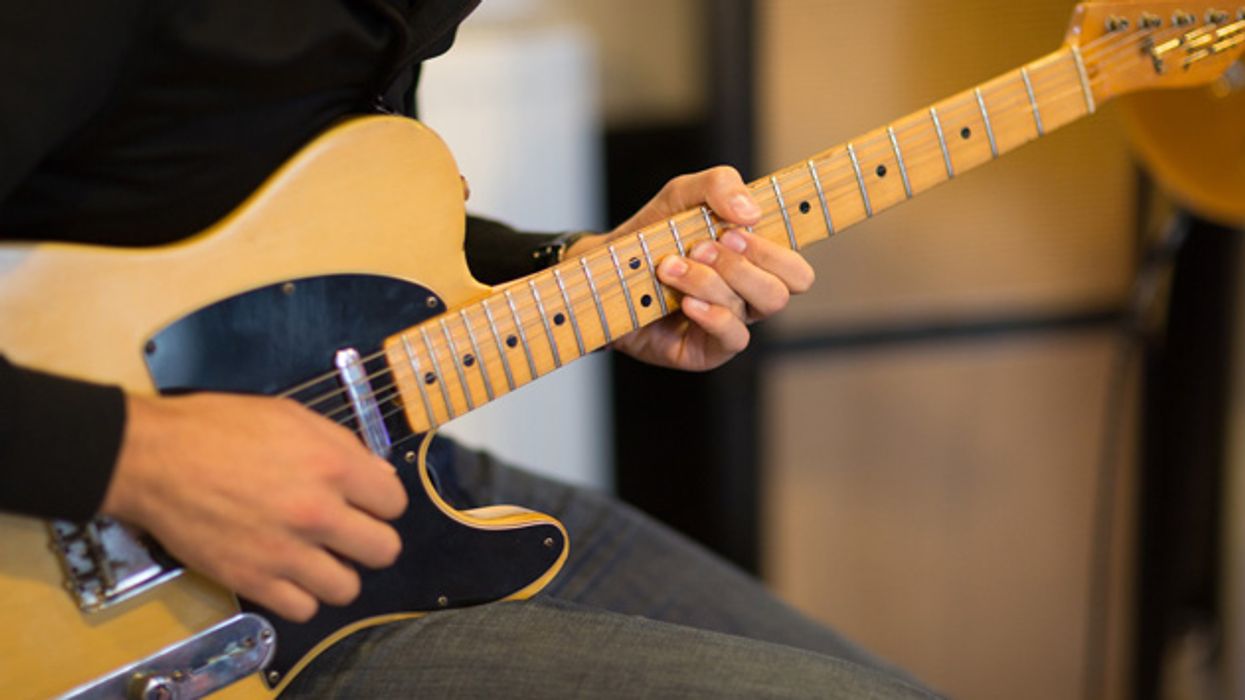
I feel a little embarrassed when people ask me about my guitar influences. I can't claim expertise of Hendrix, I haven't spent hours woodshedding Eric Johnson, and I couldn't tell you the first thing about how to play like David Gilmour. My influences are more behind the scenes, lurking in the shadows of the music industry. They don't have big names, but they are monster players. I'm talking about the number one, most honest influence on my guitar playing: Nashville session guitarists.
In case you don't know, Nashville session guitarists are the cream of the crop—they have to be. Their job is to listen to a song once, write a chart for it during that single listen, step out onto the tracking room floor and simultaneously create, react, and execute a guitar part at a radio-perfect level in one take. I've figured out some tricks by studying the work of musical sharpshooters like J.T. Corenflos, Kenny Greenberg, and Tom Bukovac, and now I get to apply it in my own career when I'm called in for a session. Now, let's steal some tricks.
“Kiss You in the Morning" Box
An important thing to remember throughout this lesson is that the goal is to sound perfect. A dead note on your guitar solo should not be the reason that one of your fellow session players is late to pick up his daughter, so this is no time for finger tapping or seven-fret stretches. I call this the "Kiss You in the Morning" box because it's similar to the signature lick in Michael Ray's song of the same name.
You want the song to sound good, which means you need to sound comfortable. That's why this pattern (Ex. 1) is a great home base for your chord-based riffing. This is a segment of a diagonal major pentatonic scale that only uses your first and third fretting-hand fingers. You don't have to stretch or remember complicated patterns, and it's almost impossible to sound bad here. Place your first finger on the chord's root, which falls on either the low 6th or 5th string, and slide your third finger up two frets to access the rest of the pentatonic notes. It's a closed shape, so you can move it all over the fretboard to whatever key or chord you need, which comes in handy when you're scanning down a Nashville number-style chart in real time and having to come up with a hook or rhythmic motif.
The “All About Tonight" Box
This one is a little tougher, but more rewarding. I could do an entire session just using this box and rearranging the notes in different ways to make my melodies and textures fit the mood of the song. You can hear hints of this pattern in Blake Shelton's "All About Tonight." This is a natural extension to the previous example, but in Ex. 2 we start to introduce double-stops (playing two notes at a time). Low notes on the lower strings sound thick on their own, but as you move up the neck it's a good idea to start using double-stops if you want to keep the guitar sounding thick. In this box, your first finger is always in charge of the same fret, and your third finger oversees hammer-ons two frets higher. To play the double-stops I'm talking about, barre the 5th and 4th strings with your first finger and pick them. Then hammer on the 5th string with your third finger. Boom. You can do the same trick with different string sets.
Open for Business
You've got some lead chops built up, but somebody will be singing for 90 percent of the song, so what do you do? In keeping with our rule that we want our playing to sound comfortable, the answer is open chords. Full barre chords give you a lot of strings to keep track of, and if your dynamics, sustain, and muting aren't spot on, then the producer is going to have to hire someone to redo your parts after you leave, and that doesn't bode well for your session career.
Throw on a capo because only five keys are generally acceptable for playing guitar in a session: G, D, E, C, and A. Is the song in Db? Put a capo on the 1st fret and play in C. How about F#? Place a capo on the 2nd fret and play in E. Even if a song is in A, 95 percent of the time the acoustic guitar player will opt to play with a capo on the 2nd fret so he or she can move around comfortably in the key of G. Ex. 3 shows some of the special open chords that session players use all the time.
Palm-Muting Verses
Wide-open chords aren't everything, though. Songs need to have structure and flow, and the band members need to be on the same page about where the song is going. If you watch a session with guitarists Derek Wells and Jerry McPherson both playing guitar, they aren't clashing. They both know how energetic the song needs to be at any given moment. Chances are you'll nail it if you play the verses a little lower in energy and the choruses a little higher in energy. You can palm-mute the lowest two strings of an open chord, or you can palm-mute a power chord, or you can palm-mute thirds that fit inside of the chord. Check out Ex. 4 for an example. Any of those routes will work to get you from the intro to the chorus. And when it comes time to do a "fill" at the end of the measure or progression, all you really need to do is unmute what you're already doing! Fish in a barrel.
My Kinda Drones
"Box" playing is great, but I'm sure you want to have more than just boxes in your toolkit. One of the best tricks for coming up with melodies that don't sound boxy is by using what I call "My Kinda Party" drone lines. The signature lick in Jason Aldean's song, "My Kinda Party," is a wonderful example of this. Come up with a melody and play the whole thing on the 2nd string. Don't get too complicated, and don't make it too fast. Make it a nursery rhyme, a simple, hummable jingle that a drunk Bonnaroo crowd could sing back to you.
To allow the 1st string to ring out as you move along the neck, you need to fret the notes on the 2nd string using the very end of your fingertips. Now pick through both the top two strings while sliding from note to note (Ex. 5). This adds thickness and texture to the melody and helps make it sound like music, so someone like super-producer Justin Niebank doesn't have to spend time adding effects to your guitar to fill out the mix. As with the open chords, make sure you have the capo in the right spot so the open 1st string fits the song's key.
Get Low
The opposite of that approach is using a technique found in Luke Bryan's tune, "We Rode in Trucks." With this trick, you place the root of the chord on one of the lower three strings and build your melody on the string above it (Ex. 6). My favorite application of this is when you hammer-on to a 3, which puts your hand right in the "All About Tonight" box we talked about earlier if you need to launch into a solo. This trick can only be done if one or more of the low open strings works with the song's key, so you'll have to do some quick mental math and capo accordingly.
Swell into It
This technique is one of the physically easiest to perform, but requires some mental energy to get right. Sometimes the song needs an ambient volume swell to hold things together over chord changes, and this requires choosing your notes carefully. Let's say the progression is Em–C–G–D, with two chords per measure. Look for the notes that both chords share in each measure. Em and C both share E and G notes; G and D both share D notes.
That's the safe route, but you can also swell into notes or pairs of notes that challenge the chord a little bit and make an extension out of it. Swelling into a D over the Em and C turns them into Em7 and Cadd9, respectively, both very cool sounds. And G to D is a pretty strong chord change in this key, so you'll probably want to stick the landing and end up on chord tones here. To change things up from just a D note you can swell in a pre-bent G note and let it down to an F# when the D chord comes in. Or do the same thing, but pre-bend a B note and let it fall to an A (Ex. 7). You can nail this approach if you know your chord tones. Note: You'll need a good amount of delay and reverb to make the most of your swells. Most players do this with a volume pedal, but with the right guitar—a Strat, for example—you can also accomplish this manually.
High Extensions
Now that we're in the mindset of thinking about what our notes do to the chords we're playing over, adding higher extensions can introduce complexity and texture to a song. I have fond memories of sitting with a friend in high school, both of us holding acoustic guitars, and playing different triads and double-stops over each other's open chord strums—just to hear how one person's triad could affect the other person's chord.
The idea is that you'd pick notes that might not be within the basic triad and use these additions to alter the song's principle chords. If a bass player plays a C, and the acoustic guitar plays an open C chord, and the other electric guitarist plays a C power chord, but you play a B and D double-stop high on the fretboard you just made the entire band sound like a Cmaj9 chord, which is really pretty sounding. If you pick G and Bb, then you made the band sound like a C7 chord, which is bluesy and sarcastic sounding. Session players know what note extensions to add to chords, what these extensions will sound like, and when it's appropriate to use them. Ex. 8 illustrates how to use this trick over a basic progression.
Simple Slidin'
On most sessions, slide is used for texture and not for Derek Trucks- or Sonny Landreth-inspired shredding, so it's mostly limited to chord tones and a couple of simple lines. It is a very cool color, though, and it's well worth learning how to navigate a melody with a slide on your pinky. Slide sounds more like a human vocal than fretted notes, so this technique can really lend itself to making memorable, catchy, singable hooks. This is part of the reason guitarist Rob McNelley is on so many records—he's able to really make slide sing. Just be very careful about not letting strings ring unless you want them to. To come up with a simple, catchy, single-note slide line that soars over the arrangement, tap into the same melody-creating brain space you used for the "My Kinda Party" example, as well as the chord knowledge required for swells and extensions. Chord tones are always safe, extensions can be really cool, and make sure you stick the landing (Ex. 9).
Dot … Dot … Dot
You made it all the way to Ex. 10, so give your brain a break and let a pedal do all the work. Delay is a powerful effect, and when you sync that delay to the song tempo, the pedal can play notes for you. If you see guitarist Justin Ostrander doing something simple, chances are there's a timed delay happening to carry the simplicity. A dotted-eighth is equal to three 16th-notes, and a dotted-eighth delay means once you play a note, that note will come around again three 16th-notes later. And if the repeats are turned up, it'll keep repeating every three 16th-notes to create a cool syncopated feel (Ex. 10).
If you play something completely straight against the syncopated pattern the delay will be creating, the delay fills in the notes between what you're playing and makes an otherwise boring figure sound incredibly interesting. To make this trick work, you'll need a delay with programmable or tap tempo. For best results, tap the tempo for quarter-notes, play eighth-notes, and have the delay set for dotted-eighth-notes.
These guitarists stay mostly out of the spotlight, but with the growing world of media they are starting to get a little more exposure with great programs like Premier Guitar's Rig Rundown with Kenny Greenberg (shown below) or Zac Childs' Truetone Lounge episode with Derek Wells.
Videos like these let you inside the world of the pro session player, and are great resources for learning more from the best in the business. Next time you hear some tasty guitar on a radio hit, you'll know it's tasty for a reason and you're one step closer to being the guitarist who gets to play it.
Lamb of God Return with “Sepsis”
Lamb of God return with “Sepsis”, a visceral, menacing new single out now via Epic Records, marking the GRAMMY® Award-nominated band’s first new original music since 2022’s critically revered album, Omens. Produced by longtime collaborator Josh Wilbur, the three-and-a-half minute track arrives alongside a grainy, lo-fi performance video that offers a moody, unfiltered look at Richmond’s underbelly. Directed by Gianfranco Svagelj, the video captures the song’s slow-burning tension.
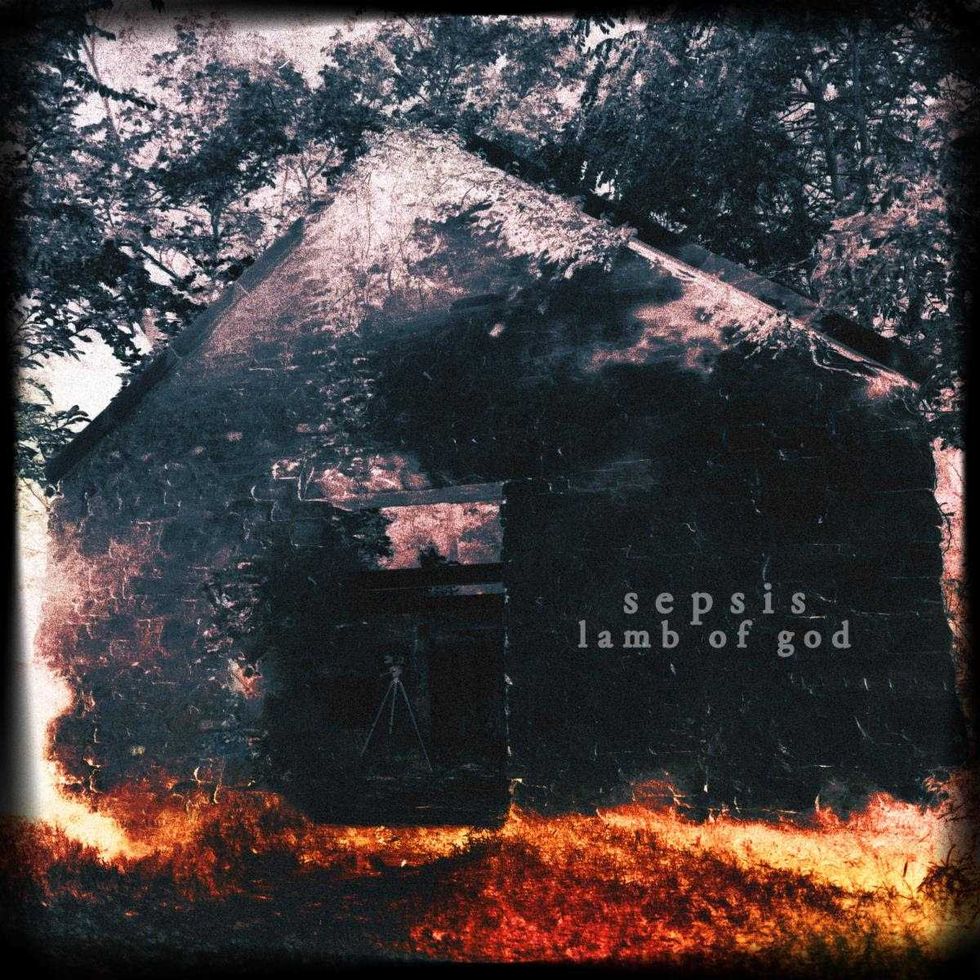
“’Sepsis’ is a celebration of the very underground local bands here in Richmond that we really admired when we were just forming Burn the Priest,” Mark Morton shares. “Bands like Breadwinner, Sliang Laos, and Ladyfinger—though they never got widespread attention outside of Richmond, those were the bands we listened to all the time. The song references that stuff in a way that’s a direct line to where we were coming from when we were in the basement writing our earliest material together.”
“Sepsis” arrives during a milestone year for Lamb of God. In 2025, the band celebrated the 25th anniversary of their discography, performed at the historic “Back to the Beginning” concert and subsequently released their thunderous take on Black Sabbath’s “Children of the Grave,” along with appearances at several festivals including Inkcarceration and Louder Than Life, and a headlining show at Richmond’s new 7500-seat outdoor venue, Allianz Amphitheater, during its opening season.
As the year closes, Lamb of God have several performances ahead of them, including outings at Aftershock, AMMA Championship Fest, and the band’s Headbangers Boat cruise (Oct. 31 to Nov. 4) – a four-day floating festival departing from Miami with a stop in Cozumel, Mexico. The line-up features performances from Clutch, Kublai Khan TX, Power Trip, Obituary, Devil Driver, Fear Factory, The Black Dahlia Murder, The Exploited, Crowbar, Nekrogoblikon, Eighteen Visions, Gideon, Walls of Jericho, Category 7, Brat, comics Josh Potter and Saul Trujillo, with appearances from Jose Mangin and Riki Rachtman. Tickets are available at Headbangersboat.com.
Lamb of God tour dates:
October 3 Sacramento, CA Aftershock Festival
October 18 Canton, OH Tom Benson Hall of Fame Stadium
October 31 – November 4 Miami, FL Headbangers Boat
November 6 Monterrey, MX Showcenter Complex
July 27 – 31 Râşnov, RO Rockstadt Extreme Fest
August 1 Wacken, DE Wacken Open Air 2026
August 7 Walton-on-Trent, UK Bloodstock Open Air 2026
August 12 – 16 Dinkelsbühl, DE Summer Breeze
August 13 – 15 Sulingen, DE Reload Festival
August 14 – 16 Eindhoven, NL Dynamo Metalfest
Tickets for all shows are available now via Lamb of God’s website.
How a Four-Pickup Vintage Teisco Electric Continues to Inspire
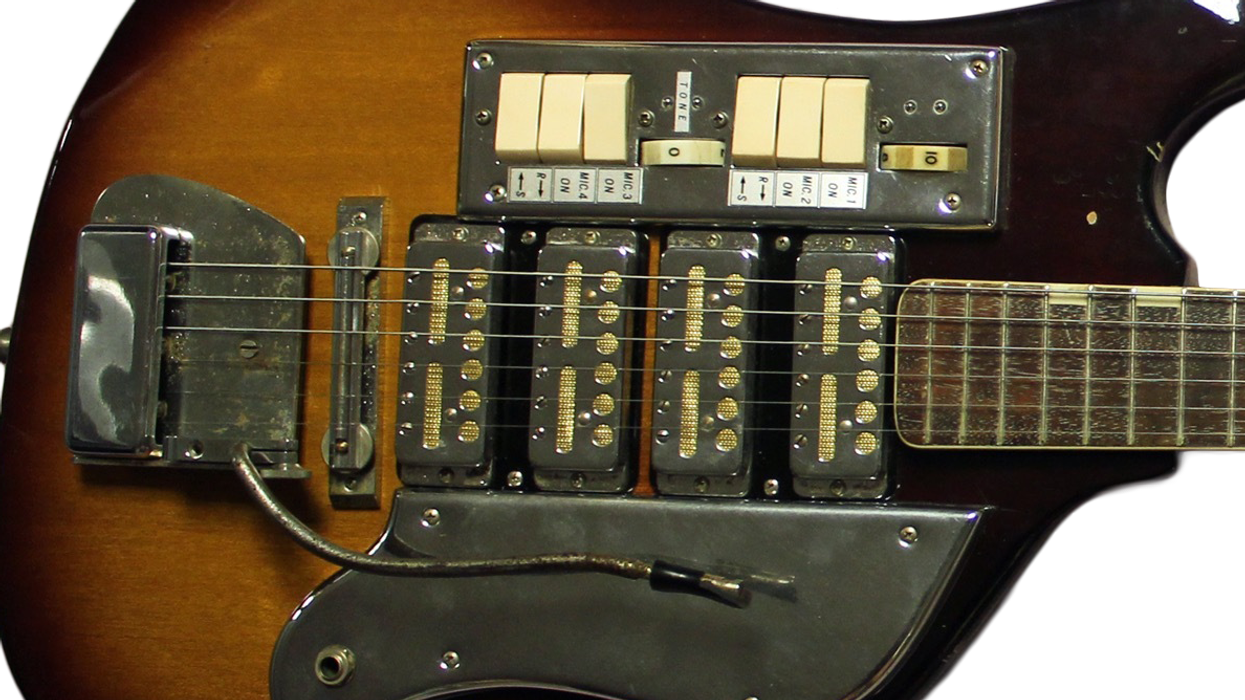
Lately, I’ve been thinking about coaches and teachers—you know, the people in your life that have brought out the best in you. My daughter is now off to college, and my son is entering 10th grade, so I’ve been reflecting on our common experiences. My boy is playing sports and currently has a pretty good coach. The guy is supportive and involved, but still has a little "old-school" in him. When I was a kid, my coach was a “bucket” coach, meaning he brought a five-gallon bucket onto the field and flipped it over so he could sit and criticize everything we did wrong. He’d throw his hat and cuss and generally rule by intimidation! Times have certainly changed, brothers and sisters.
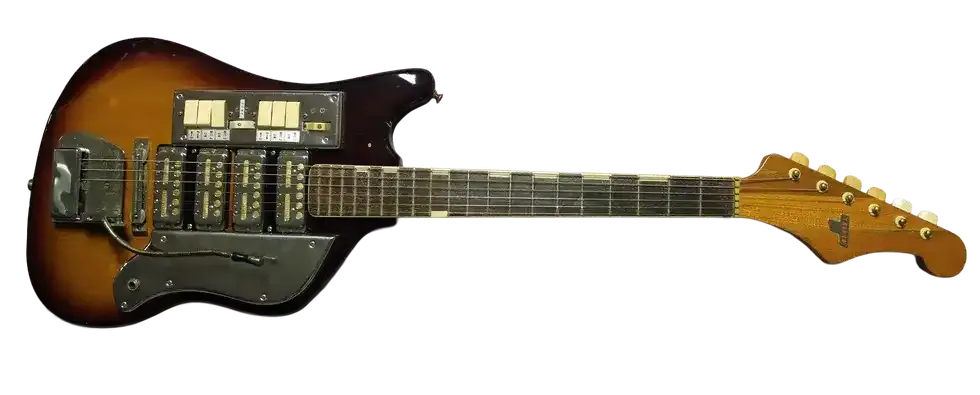
In my old age, I’ve come to learn that the best teachers and coaches were the ones who were excellent motivators: the people who could bring out the best in your performance and learning. Often, motivation comes from knowing that you’re seen and valued, even if you aren’t the sharpest knife in the drawer or the best athlete on the team. These types of people can be hard to find, but we all certainly remember them.
For me, it was Mr. Bryant in the 12th grade. He was a coach, a musician, and a phenomenal educator. I had just lost my dad before my senior year, and he totally tried to lift me up to keep playing sports and stick with guitar. He was a drummer but still had a fine guitar collection, and he would let me choose any one to play. He’d always ask which guitar “spoke” to me. Was it looks, feel, playability, sound, or something else? It’s like when Harry Potter’s wand found him, I suppose. So I ask you, faithful reader, which guitars speak to you? Which guitar gets you motivated to play, and which one inspires you as soon as you play it? Are you still on the hunt, or has your magic wand found you?
My most inspirational guitar is the early ’60s Teisco SS4L. Hailing from the beginnings of Teisco, the SS guitars were among the first to feature the now-famous gold-foil pickups. Of course, the 4L had a quartet of them! This is a guitar where everything is exaggerated to an absurd degree. The electronics feature four switches (pickup on/off) and multiple tone knobs and presets between the rhythm and lead circuits. The body is all out of whack, almost like a goofy-looking potato, and the headstock is elongated to excess. And then the chrome … like an old muscle car! The tremolo on this particular one is a very sophisticated floating unit that’s held together by string tension. Not the easiest to change the strings. These guitars came with one to four pickups and were primarily made from 1962–64. There is every flavor of sound in this guitar, something for every palette. Thin surf, raging blues, spaghetti western … you name it.
“There is every flavor of sound in this guitar, something for every palette.”
These SS4L guitars always inspire me to play because they offer all kinds of adjustments to the tone and tend to bring out the best in my playing. Normally, I’m a set-it-and-forget-it player. But with these guitars, it’s a chance to get creative, and the pickups add to the stew. The body feels kinda clunky and doesn’t balance very well, but the necks all have a nice, deep, full feel, often with a pronounced V-shape, which I totally dig.
I think I currently own four of these guitars, but the one pictured with this column is hanging right by my work bench to offer me a little motivation. I have plenty of nice guitars. Some play better, some feel better, and some sound better. But for whatever reason, I am drawn to this model, and that infatuation has lasted through the years. Oh, and you know what else? The “bucket” coach that I had still comes to watch football practice! He’s not always on a bucket these days, and he’s not yelling at anyone, but he’s still motivated.
Stompboxtober 2025: StewMac
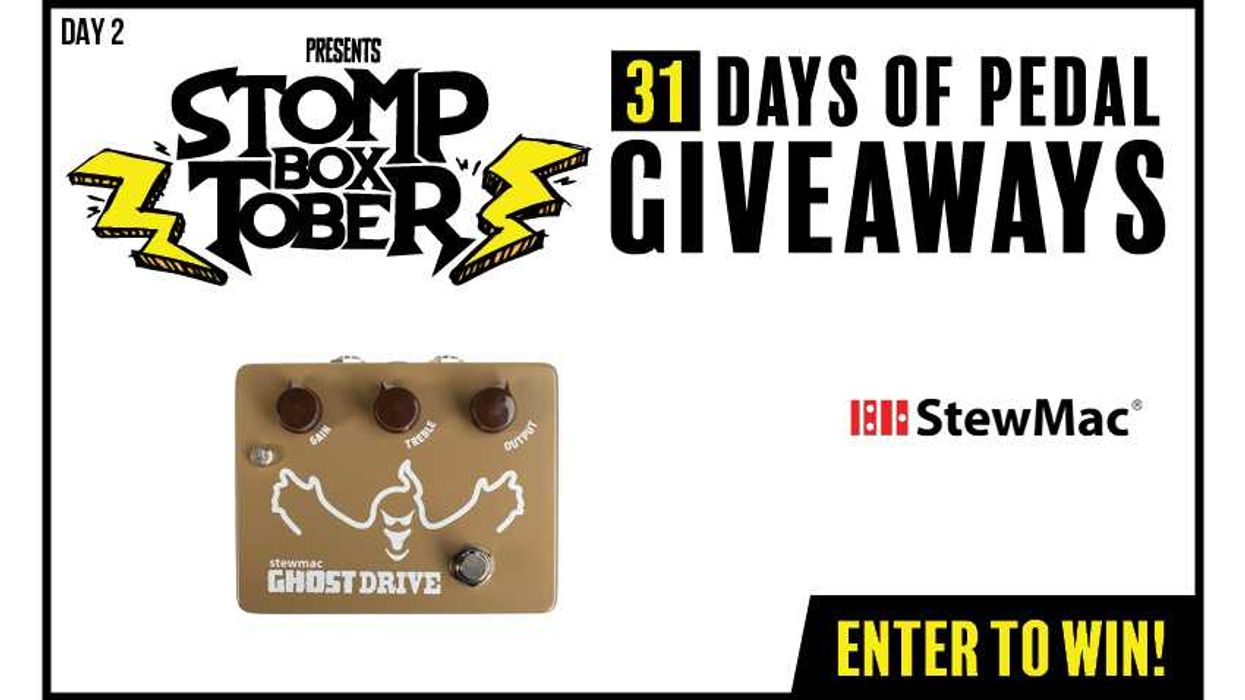
Stompboxtober is back for 2025! Come back all month long for your chance to WIN daily pedal giveaways. Today's featured giveaway is the StewMac Ghost Drive!
Stompboxtober 2025 - Win Pedals All Month Long!
Ghost Drive Transparent Overdrive Pedal
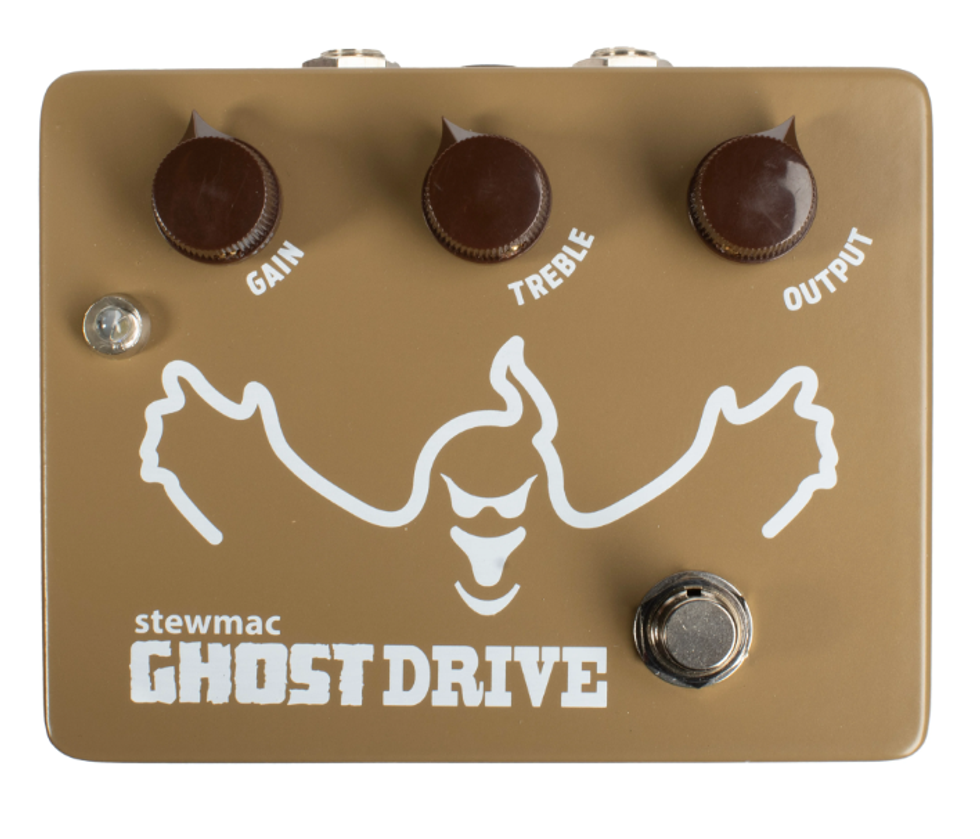
Four years ago, we put our heads down and dove headfirst into the most hyped pedal of all time. We wanted to see what really made the mythical Klon Centaur Transparent Overdrive so special—what was inside this thing that turned it into legend. We pulled it apart, piece by piece, to deconstruct the magic, if you will.
Then we rebuilt it. Faithfully recreating the circuit, scouring the globe to track down the very same components Bill Finnegan used in the originals. The goal wasn't "close enough." The goal was a true tribute—authentic down to the tiniest detail.
Here's the thing: original Klons still sell for $5,000–$10,000 on Reverb. That puts them out of reach for most players. We wanted to change that—to capture the authentic tone of a legend and make it something within reach of any guitar player.
Sweetwater Rocks Out with GuitarFest Event
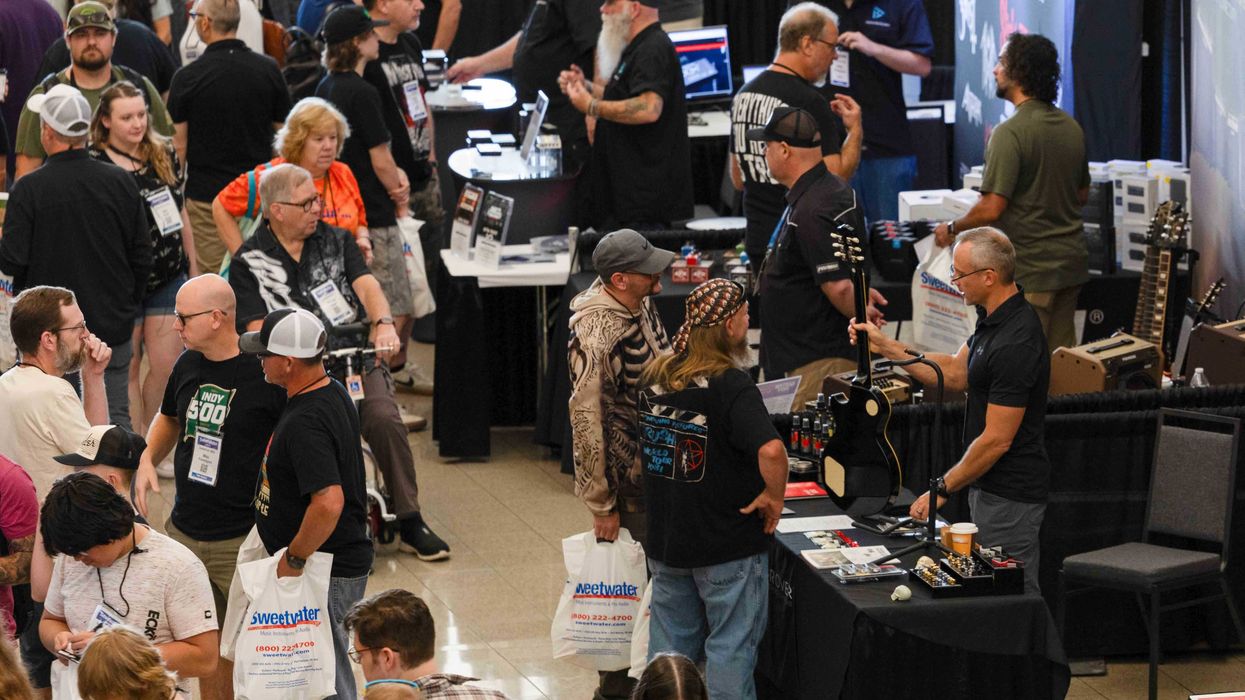
This past weekend, Sweetwater had the pleasure of welcoming guitar enthusiasts to our Fort Wayne, Indiana, campus for GuitarFest. The event featured over 70 manufacturer booths, more than 20 world-class guitarists, and numerous industry leaders, all coming together for a celebration dedicated to the guitar.
“It was an incredible event,” shared Samantha Hunter, Director of Artist Relations and Campus Productions at Sweetwater. “Music enthusiasts and guitar players had the unique opportunity to see up close the very latest gear and engage directly with the manufacturers. Additionally, fans had a chance to meet some guitar legends and collect autographs, creating lasting memories for all that attended.”
Held on Saturday, September 27, GuitarFest was a one-day event that drew several thousand music fans from all over the Midwest. The event underscored Sweetwater’s commitment to creating a community for music lovers and providing opportunities to share the passion of music.
Sweetwater is very appreciative to everyone who came together to make this event such a success. GuitarFest was made possible because of our partnership with our vendors, the artists, and our employees.
About Sweetwater
The number one online retailer for music makers, Sweetwater is trusted and beloved by millions of musicians, sound engineers, band and orchestra directors, and podcasters who rely on the company to help advance their musical and creative journeys. From beginners to rock stars, music makers everywhere seek out Sweetwater’s industry-leading expertise, including in-depth product videos to inform their purchases and unrivaled post-care support. Headquartered in Fort Wayne, Indiana, and founded in 1979, Sweetwater Sound, LLC credits its four decades of profitability to its now 2,500 employees and its deep understanding of the profound connection that music makers have with their craft, their gear, and the creative process. Sweetwater is amplifying change through music, lifting up communities by creating, empowering, and caring about the music makers of tomorrow and today. For more information, visit Sweetwater.com/.
Vernon Reid: Gathering Signals from Across the Musical Universe
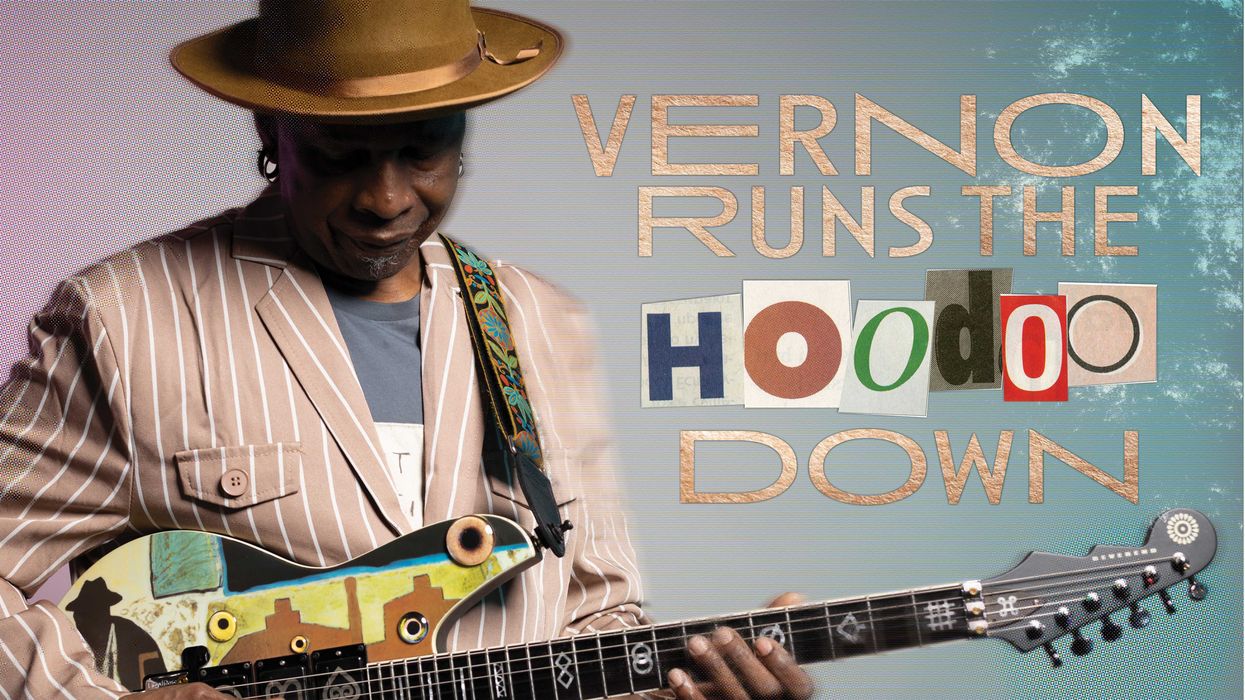
“Avant-garde, jazz, pop, rock ’n’ roll ... if some aspect of the human condition comes through in the music, that’s what animates me,” Vernon Reid says about his approach to sound. “It animated me before I even picked up the instrument. And it has animated me all the way through.”
It’s this unwavering commitment to human connection over stylistic boundaries that has defined Vernon Reid’s career—and it’s perhaps never been more evident than on his new solo album, Hoodoo Telemetry. Reid is speaking to Premier Guitar from what he calls the DharmaLab, his home studio on Staten Island. The name nods to the Dharma Initiative from the TV series Lost (“I’m a big fan,” he says), and like that show’s mysterious island, the Living Colour guitarist’s musical world follows its own rules, where seemingly disparate elements meet to create something entirely new.
Hoodoo Telemetry, his first album released entirely under his own name since 1996’s Mistaken Identity, embodies this philosophy. The title itself speaks to the collection’s nature: “hoodoo” suggests mystical forces and folk magic, while “telemetry” implies the gathering of information from distant sources. “I can understand why anyone listening to it would go, ‘This is all over the place,’” Reid acknowledges. “But I’ve kind of been all over the place, really, in every context I’ve been in.”
The path to Hoodoo Telemetry began years ago, pre-Covid, but that “huge interruption” fundamentally shaped the record’s final form. During those lockdown days, Reid found himself cycling over New York bridges, taking photographs, playing guitar, and contemplating where he wanted his music to go.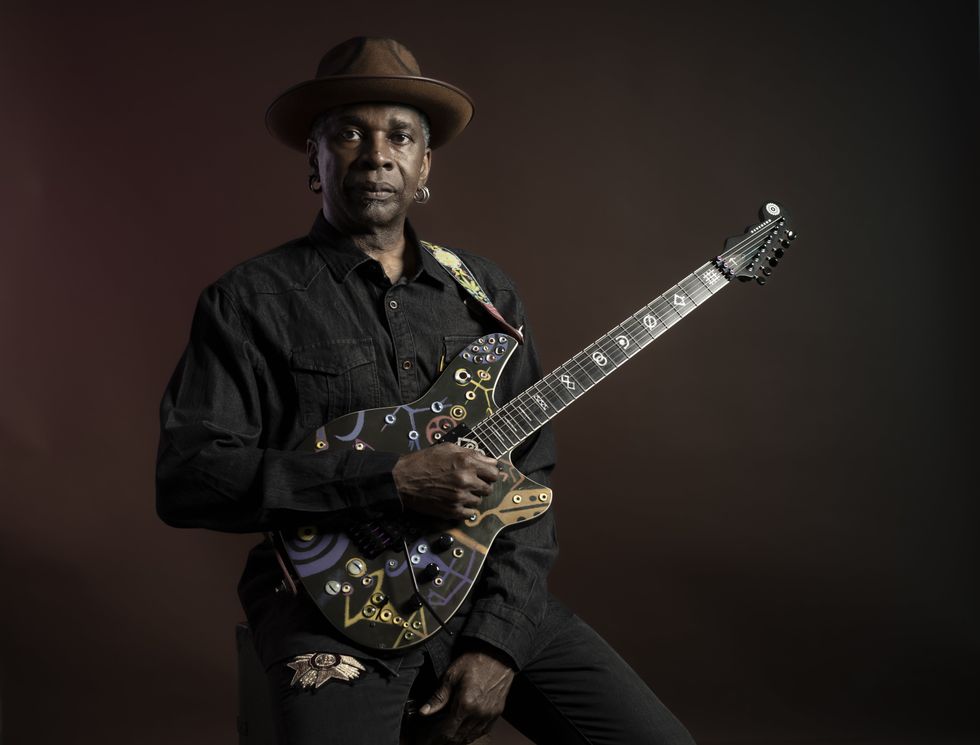
Then tragedy struck. Reid lost his close friend Greg Tate, the influential writer, guitarist, and critic who had been instrumental in his early career. Though Tate didn’t die from Covid directly, Reid considers him a Covid victim due to the stress the pandemic placed on the healthcare system. “We think about the victims of Covid as the people that had Covid themselves,” he says, “but there were plenty of other people that, if the healthcare system wasn’t strained by Covid, they would’ve have survived their situations.”
The loss proved pivotal. Tate had written the first serious article about Reid and his music, and the two had been co-founders of the Black Rock Coalition. Tate passed on December 7, 2021—the exact same date, Reid says, that the Black Rock Coalition held its first public event, in 1985. “It was a traumatic thing, and it sort of reframed or focused what I was doing—I wanted to make a record that Greg would like.”
Indeed, Tate’s influence permeates the album. Burnt Sugar, Tate’s experimental collective, is featured on three tracks, while Reid also says his friend encouraged him to sing more (which he does, on the track “In Effigy”). “[Greg] said, ‘Man, you have a quality to your voice,’” Reid says. “‘You have a thing,’ you know?”
There are other elements woven throughout Hoodoo Telemetry. “Part of the thread in the album is the idea of the diaspora—the idea of being adrift,” Reid says. This is reflected from the first track, “Door of No Return,” which draws on the historical term for the final passage of enslaved Africans leaving their homeland for America, to the closing number, “Brave New World,” which takes its title from Aldous Huxley’s cautionary dystopian novel. “Where’s the center, right?” he continues. “Especially when you realize the trip is a one-way trip.”
Musically, the album has an eclectic and adventurous spirit. There’s “Politician,” Reid’s take on the Cream classic. The choice reflects both personal history—Reid played the song with Jack Bruce in the band Spectrum Road—and contemporary relevance. “It’s my favorite Cream tune,” he says. The sentiment behind it, meanwhile, is “an evergreen thing,” he continues, “what with these jive so-and-sos….”

“Ever since I saw Clapton with The Fool, I’ve loved guitars with graphics.”
Another song, “Freedom Jazz Dance,” emerged organically during recording sessions at Super Giraffe Sound in Brooklyn. Originally planned as an instrumental, the tune transformed when Burnt Sugar vocalist Bruce Mack suggested incorporating Eddie Jefferson’s vocalese version. The result became what Reid describes as “this kind of ‘60s sci-fi version of the song.”
Perhaps most poignant is the skittering, atmospheric “Good Afternoon Everyone,” built around a found vocal recording Reid captured in the subway, where a homeless man repeated the same request with unchanging inflection: “Good afternoon, everyone. Can anybody help me with something to eat today?” What initially seemed like mere politeness revealed itself as controlled anger. “I realized, okay, he’s enraged. He’s not just being polite,” Reid says. “But his affect didn’t change. It was really chilling and really poetic.”
The track exemplifies Reid’s approach to social commentary through music. Collaborating with rapper Nironic, “Good Afternoon Everyone” explores homelessness from multiple perspectives. “One of the things [Nironic] did was that he pivoted,” Reid says. “At one point, he’s the person ignoring the homeless person, and then he flips, and he’s also the person seeking aid. I thought that was pretty cool.”
While Reid’s conceptual concerns drive much of Hoodoo Telemetry, his guitar work—the element that, of course, first brought him to prominence—remains equally compelling throughout, expertly balancing furious blasts of technical prowess with emotional expression. Reid can shred with the best of them, but he’s equally capable of restraint when the music demands it.
The contrast between tracks like “Door of No Return” and “Brave New World” illustrates this philosophy. The former demands intensity: “‘Door of No Return’ is really about a kind of feeling,” Reid says. “It’s a certain energy. It’s about loss, it’s about rage. It’s about figuring out, where do I go from here? You’re not going back home. And that requires a certain kind of approach.” Meanwhile, “Brave New World” prioritizes melodic content over flash. “That little guitar melody in the song is more important to me than the solo,” Reid says.
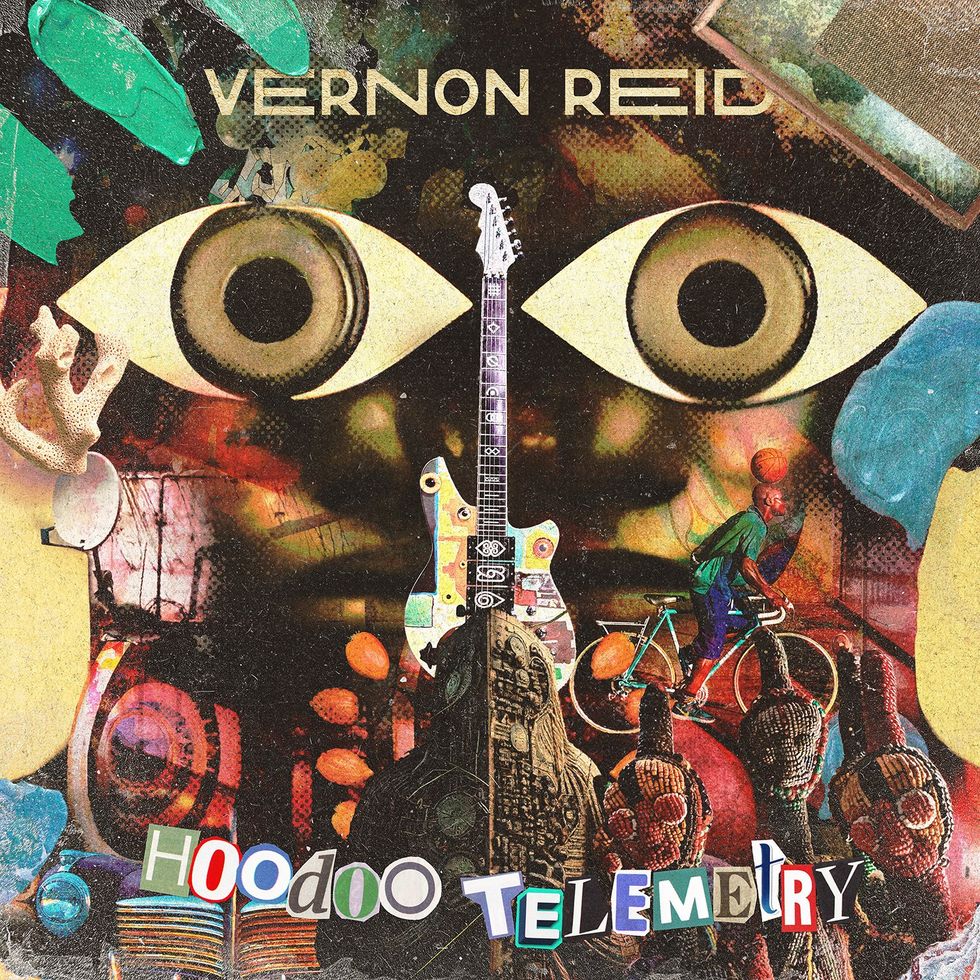
“If you think something is impossible, there’s no way forward.”
For Reid, it’s all about understanding and serving the musical moment. “What does music mean, and what’s the right thing to do for a particular song?” he says. “There are times I can sit there and go, ‘Okay, I wanna play this, and the song could be just a vehicle.' But there’s a balance. Because, man, playing fast is thrilling. But figuring out an approach against a harmonic background, or improvising something, that’s thrilling, too. And at the same time, it has to work for the song. Something like ‘Good Afternoon Everyone,’ that’s not a song for a flash solo. It’s a song for a vibe. That’s one of the things I loved about Prince. He always got that. Because somebody like that, you can do whatever. But the question is, why?”
“Meditation on the Last Time I Saw Arthur Rhames” serves as perhaps the album’s most personal statement (as well as a vessel for some of Reid’s wildest, most thrilling lead playing), honoring the avant-garde New York City-based musician who profoundly influenced Reid’s understanding of guitar possibilities. “Arthur Rhames used to play stuff at Prospect Park [in Brooklyn],” Reid says. “And it was only when I heard Allan Holdsworth that I said, ‘Oh, that reminds me of what this guy in Brooklyn used to do.” The track combines blues elements with modal, Coltrane-influenced improvisation, “and there’s also influence from Sonny Sharrock and Pete Cosey, especially when he was playing with Miles [Davis], doing that super psychedelic, heavy, mysterious thing,” Reid says. “One of the things I love about Miles in that period is he wasn’t trying to explain. He was like, ‘You either got it or you ain’t get it.’”
When it comes to the actual guitars on the record, Reid points out that the recording of Hoodoo Telemetry mostly predates the arrival of his current signature Reverend model, drawing instead from his extensive collection of instruments accumulated over the years. “Some of the stuff is my old Hamers,” he notes, referencing his custom Chaparral and the model he calls “Yin-Yang,” which appeared on multiple tracks. He also utilized his signature PRS S2 VR Vela, a Gibson ES-345, and a Stephen McSwain guitar with an aluminum flag top design that he nicknamed “Tuskegee.”
That said, his Reverend signature model does make appearances, notably on tracks like “In Effigy” and “Brave New World,” which were recorded more recently. The Reverend features his preferred V-shaped neck profile, a specification he’s maintained since his ESP days, as well as a trio of custom Railhammer humbuckers that he says are “pretty amazing for the way they take to overdrive and distortion.” Visually, the guitar reflects Reid’s affinity for striking graphics. There’s symbology inspired by the likes of Carl Jung, Joseph Campbell, and Jean-Michel Basquiat imprinted on the body, inlays in the shape of “hobo signs,” and pickup covers sporting African Adinkra symbols. “I wanted to put together something that was almost like an outsider art-type project,” Reid says. “And when we were coming up with the images and designs for it, what we wound up at was, why don’t we just do it as a series?”
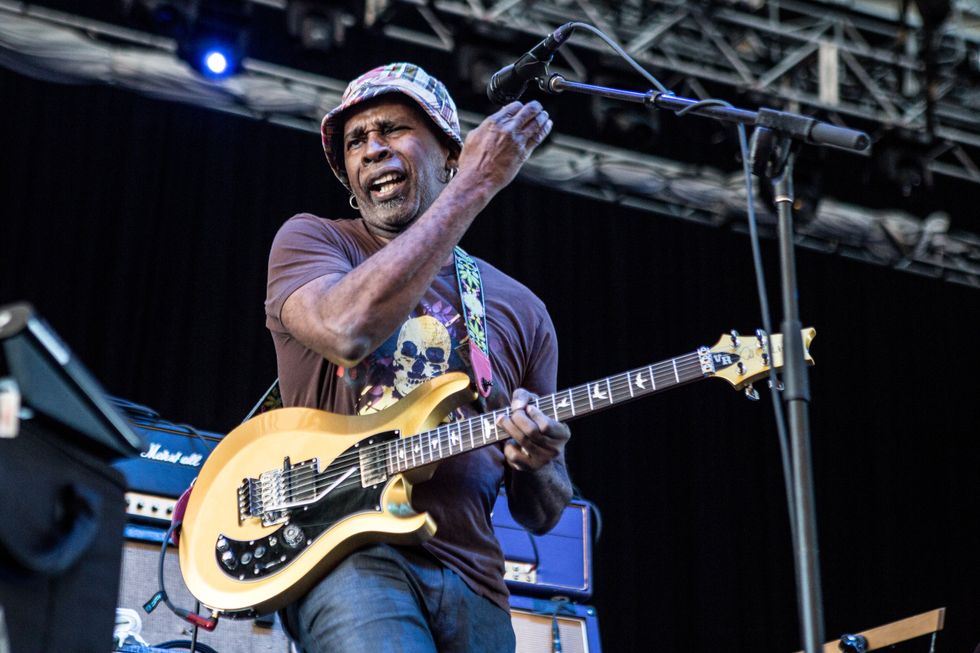
The collaboration with Reverend, which is known as the Totem Series, embodies his lifelong appreciation for guitars as visual art. “Ever since I saw Clapton with The Fool, I’ve loved guitars with graphics,” Reid says. “And I always loved stickering guitars. Because they are a canvas, you know?” And not just for him: “I recently ran into Jack White at Memphis Airport, and we wound up trading signature models,” Reid recalls. “I gave him a [Reverend Totem Series] Mystery Tramp, and he gave me a [Fender] Triplecaster. And then he did the same thing with Kirk Hammett—they traded signature guitars. I think it’s really nice when that can happen between players.”
Like Hammett and White, Reid is an iconic figure in the rock-guitar world. But if his success with Living Colour seems almost paradoxical given his deep roots—and experience—in jazz, experimental, and avant-garde music, he sees it as part of a natural continuum shaped by early exposure to diverse music. “My folks, they never told me what music I should or shouldn’t listen to,” he says. “The only thing they said to me was, ‘Turn it down—it’s loud!’ But they never said, ‘Don’t listen to that.’ I was never policed.”
Growing up in New York City also helped. Reid recalls going to “Music Row”—the stretch of 48th St. in Manhattan that for decades was home to famed gear outposts like Manny’s and Sam Ash—and rubbing elbows with the likes of Leon Russell, Mark Knopfler, and George Benson. “You would just see these guys walking around, and that made impossible things seem not completely unattainable,” he says.
Vernon Reid’s Hoodoo Telemetry Gear
Guitars:
Reverend Vernon Reid Totem Series “Mystery Tramp”
’90s-era Hamer Custom Chaparrals, including “Yin-Yang” model
Hamer DuoTone
Parker Fly VR Dragonfly prototype
PRS McCarty Semi-hollow
PRS S2 VR Vela signature
Gibson ES-345
Stephen McSwain electric
Don Musser concert acoustic
Eko 6-string banjo
Amplifiers
Mesa Boogie Dual w/ Mesa cabinet
Laney Ironheart
Fender Twin
Kemper Profiler
Effects:
Line 6 Helix and Helix Floor
Line 6 POD Go
Eventide H9, H90, Rose
Chase Bliss Warped Vinyl HiFi, Generation Loss, and MOOD
Red Panda Tensor and Particle
Digitech XP-300 Space Station, FreqOut, Whammy Ricochet, and DOD Mini Expression
Alexander Pedals Super Neo-Matic
Source Audio Nemesis and Collider
Mission Engineering Expressionator
Roland VG-99
Boss SY-300 Guitar Synthesizer
Software
Ableton Live
Pro Tools
Native Instrument Guitar Rig
“Playing fast is thrilling. But figuring out an approach against a harmonic background, or improvising something, that’s thrilling, too.”
New York was instrumental to Living Colour’s development as well. “Living Colour happened because of CBGB,” he says. “Without CBGB, we wouldn’t have built our local following. And that also goes for the Ritz, the Cat Club, the Mudd Club, all these places. Living Colour wouldn’t have happened without me playing with Ronald Shannon Jackson and the Decoding Society,” he says of his time with the downtown avant-jazz collective. “And the reason why it wouldn’t have happened is because, from that, I learned it’s possible. That’s it. That’s the whole point. Because if you think something is impossible, there’s no way forward. I mean, nobody should play the lottery, right? Nobody should play Powerball. Logically, it’s a fool’s errand. Except for the fact that people win, right?”
That notion of possibility against the odds is what drives Reid’s continuing musical evolution. Even as he unleashes Hoodoo Telemetry, he’s assembling “a small but mighty ensemble” featuring longtime collaborators Leon Gruenbaum on keyboards and Steve Jenkins on bass for upcoming shows, including a performance at the Blue Note in New York City. And then there’s a new Living Colour record on the horizon, which, Reid says, “We’ve been in the process of writing,” as well as the possibility of performing music from his solo albums, stretching from Hoodoo Telemetry all the way back to Mistaken Identity. “It would be really fun to do that with the band,” he says. “And I’m excited about all of it. I’ve just gotta thread the needle, and away we go.”
VegaTrem Introduces VT1 Special With Brass Block
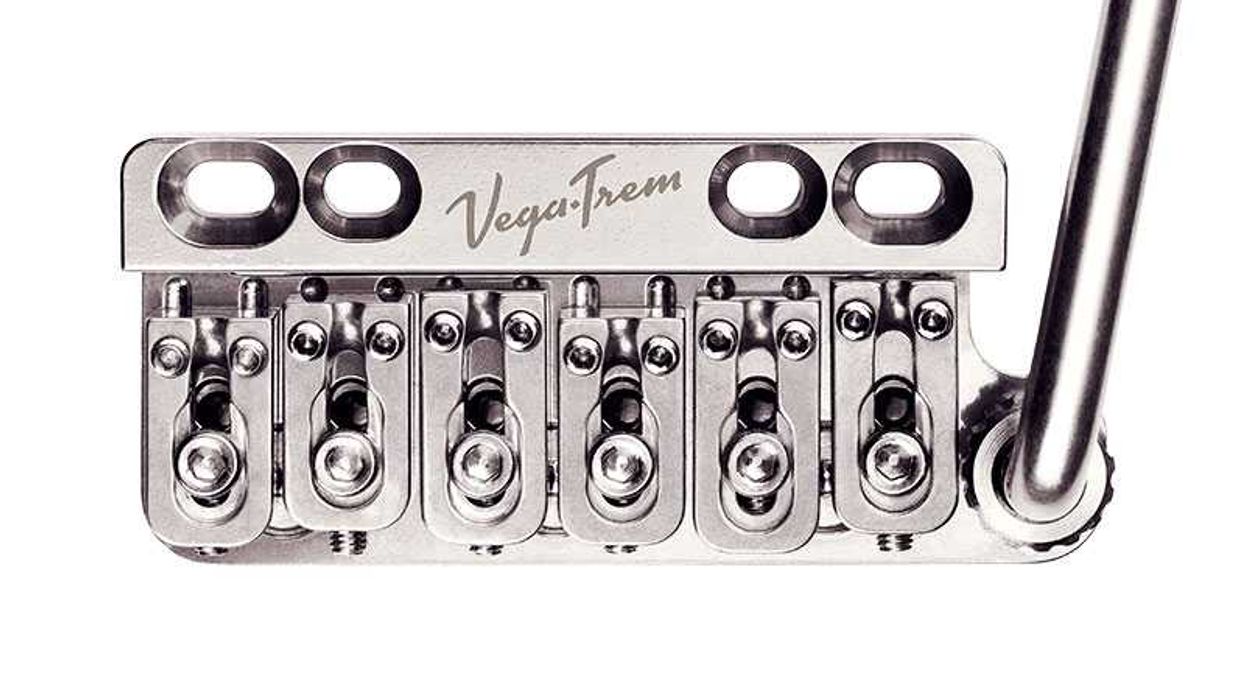
VegaTrem has unveiled the VT1 Special, a new take on the company’s iconic VT1 UltraTrem blueprint.
The VT1 Special utilizes a new brass block at its core, offering a friendlier price point while retaining all the key attributes that have made VegaTrem an essential choice for so many guitarists: it can be installed while keeping your guitar completely intact, and offers wide tonal range, simplicity and rock-solid tuning.
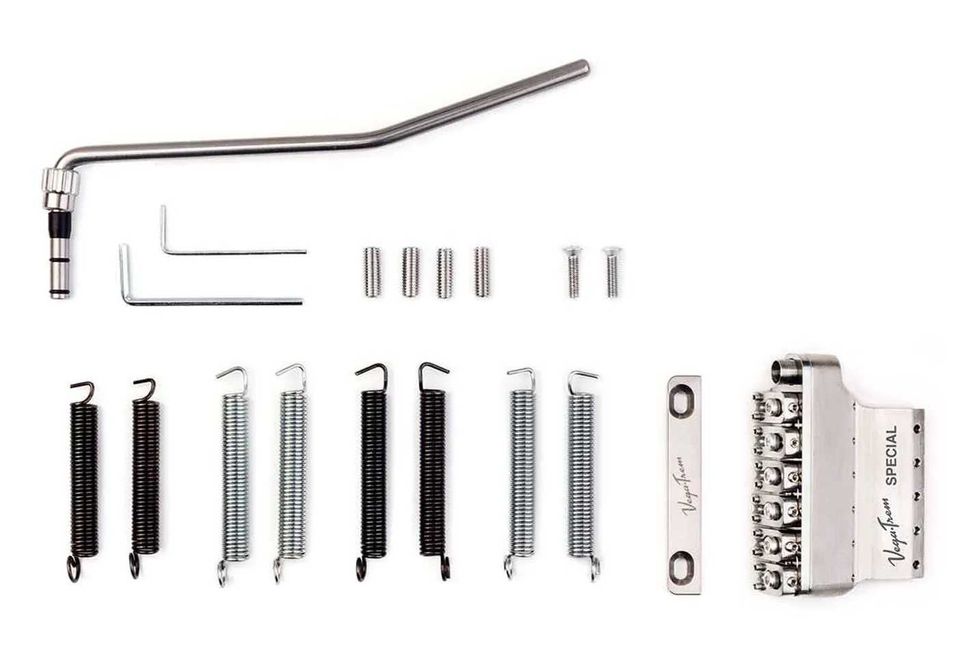
The VT1 Special is available in standard (6-screw) and 2-point versions in four different premium finishes (Glossy, Gold, Black, Satin) with left-handed options.
‘We at VegaTrem have reverential respect for all those guitarists that have given us so many great moments,” says Isaac Vega, guitarist and VegaTrem founder. “VT1 Special is our way of opening the door of the VegaTrem tremolo spirit to even more players—no drilling, no sanding, no surgery.”
By adopting a premium brass block, the new VT1 Special delivers a distinctive timbral palette that broadens the musical possibilities of the VegaTrem tremolo family—while preserving the hallmark feel and stability players expect from VT1.
The VegaTrem VT1 Special is available starting at $199 USD / €170 and can be purchased from dealers worldwide and at vegatrem.com.
Tommy Emmanuel on Onstage Curveballs, Recording Stories & Tone Philosophy
The Certified Guitar Player chats (and jams) with John Bohlinger about recording his new album Living in the Light, detailing his philosophy on tone and live sound, his focus on song arrangements and melody, hitting the onstage curveballs, and why he’ll never retire from being happy (performing).
Visit StewMac: https://stewmac.sjv.io/APO2ED
Synergy Amps Launches the Marshall JMP Preamp Module
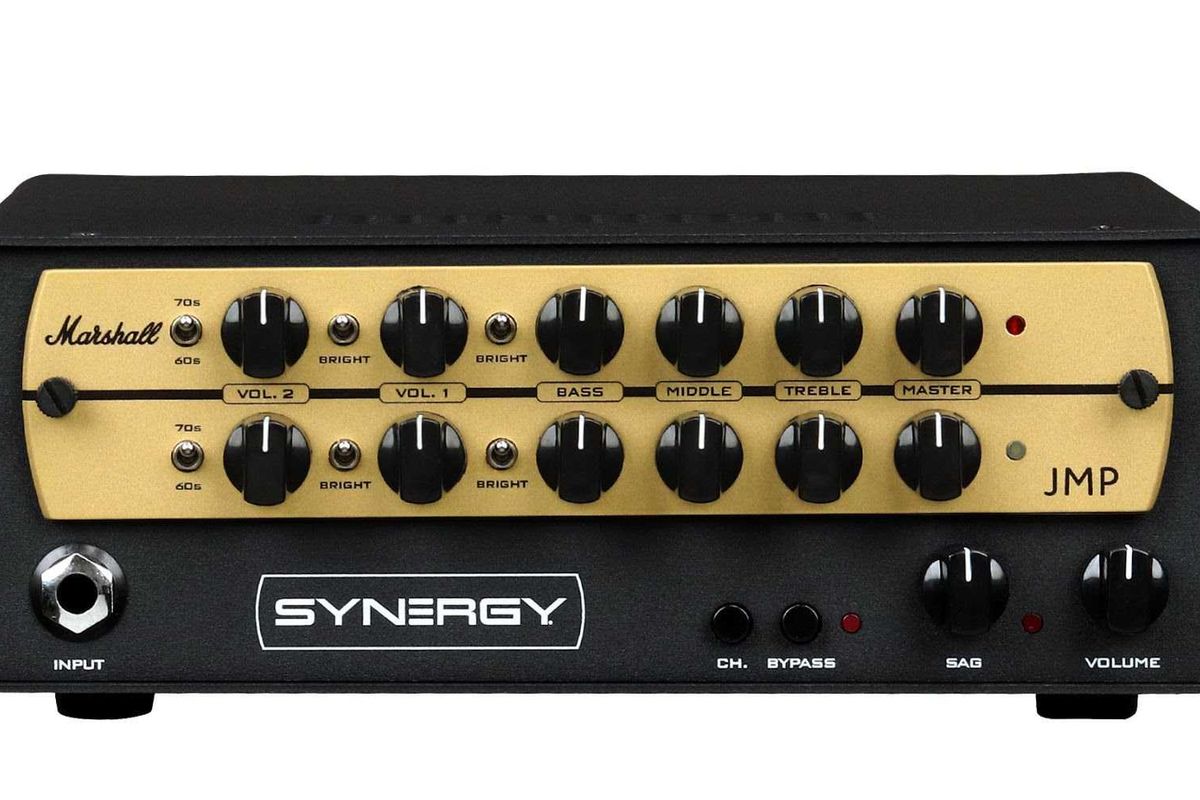
Synergy Amps today announced the release of the Marshall JMP Preamp Module, developed in partnership with Marshall Amplification. This all-tube, two channel module delivers the unmistakable growl, touch sensitivity, and dynamic response of the legendary JMP - now in a compact, modular format designed for today’s players.
From Eric Clapton and Jimi Hendrix to Jimmy Page, Eddie Van Halen, and Angus Young, the Marshall JMP amps have shaped the sound of rock for generations. With the new Synergy JMP module, guitarists can now harness that iconic Plexi tone at any volume, with the flexibility of Synergy’s modular system.
The JMP has always been about raw energy and expressive touch, and now players can access that authentic tone through the Synergy platform - without compromise.
The JMP module captures every nuance of the classic circuit with the following features:
- Dual 12AX7 preamp tubes for real-tube harmonics.
- Two independent channels with Volume 1, Volume 2, Bass, Middle, Treble, and Master controls.
- 1960s and 1970s voicing switches to replicate era-specific JMP tones.
- Four Bright switches to fine-tune treble response.
- Cathode Select switch for classic input tube configurations.
- An innovative “0-watt power amp” phase inverter design that replicates the feel and dynamics of a cranked Marshall head.
With the Synergy system, players can build their ultimate all-tube rig without sacrificing authenticity with modules from the world’s most coveted amp designers - Friedman, Soldano, Bogner, Fryette Engl, Diezel, Pavey, Dr. Z and now the most famous of them all – Marshall.
Pricing & Availability
The Synergy Marshall JMP Preamp Module is available beginning September 26, 2025, at an MSRP of $399.99.
For more information, visit www.synergyamps.com
Limited Edition Orange Amplifiers Rocker 15 & 32
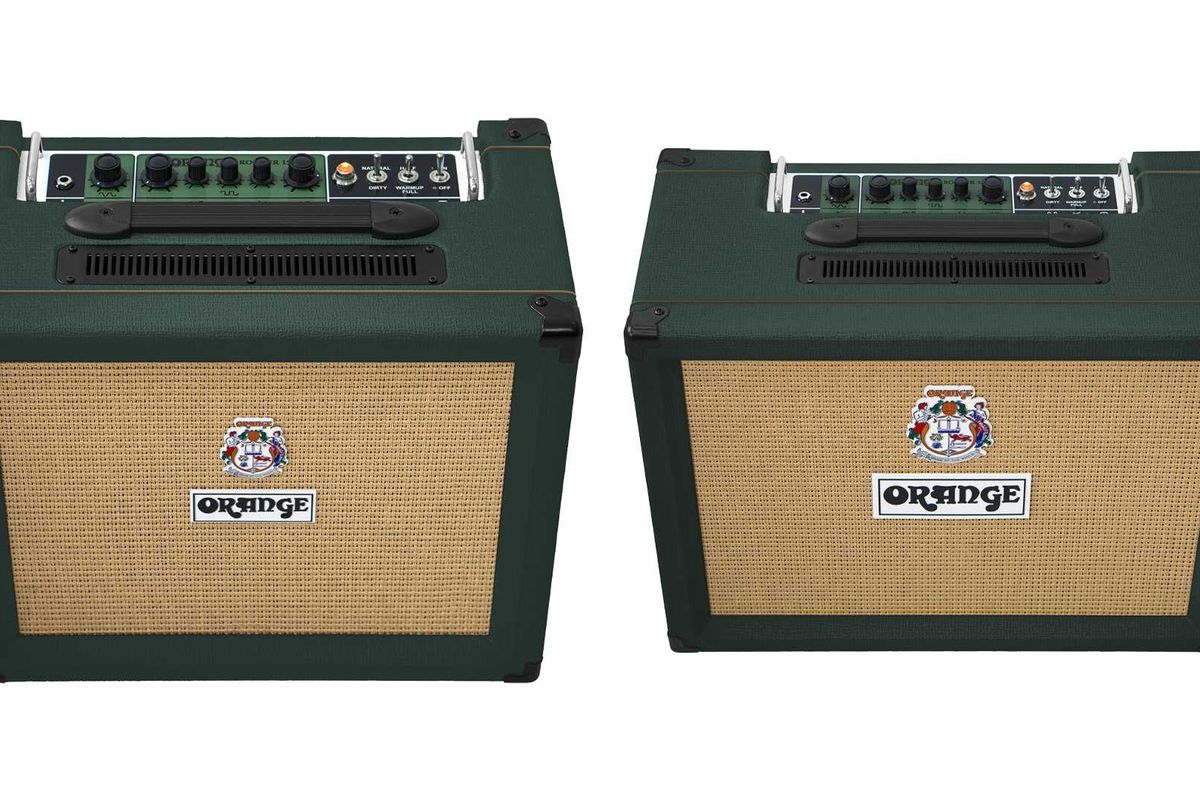
The Rocker 15 & 32, Orange Amplifiers’ amps for all occasions, are now available as a special Limited Edition in eye-catching British Racing Green featuring CELESTION G10N-40 speakers. Each combo comes with a Certificate of Authenticity, signed by Cliff Cooper, CEO and Founder of Orange Amps.
Both the Rocker 15 & 32 are deceptively versatile combos, suitable for many different venues and countless music genres. They are small, portable, two channel bedroom-friendly, all-valve amps you can legitimately gig with.
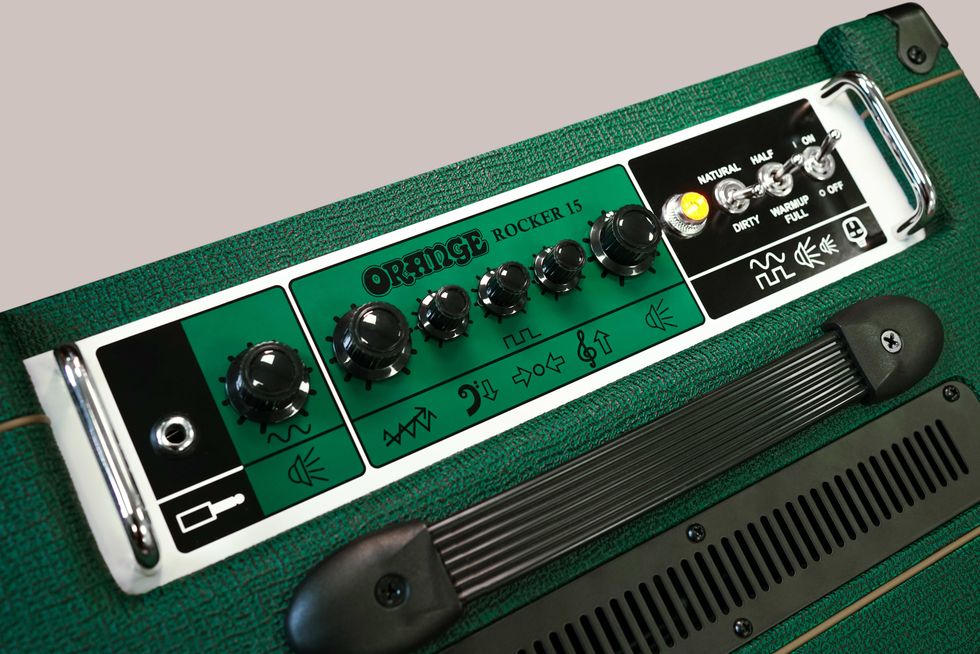
The small, two channel, all-valve Rocker 15 features a CELESTION G10N-40 speaker and beefy transformers for a potent delivery, which takes full advantage of its EL84 output section. Capable of 0.5,1,7,or 15 Watts of output, the portable combo, with a miniature footprint, oozes warm compression and fat, full tone. The twin channel output features a twist; the Natural channel is a purist’s dream voiced to bring out the ‘natural’ sound of the instrument being played, while the more familiar Dirty Channel offers plenty of British crunch. Its full and half-power switch, combined with the bedroom and headroom switch, means it is a home friendly amp that can be legitimately gigged with. It is available in a strictly limited quantity of three hundred units, worldwide.
Full of classic Orange mojo, the true stereo Rocker 32 has been fitted with two CELESTION G10N-40 speakers for a well-balanced tone with satisfying, deep lows right through to a well-defined top end. Its clever circuitry gives the amp a wide sound spread, while the stereo effect loop opens up limitless possibilities and makes it the perfect pedalboard partner. In particular, the ‘wet/dry’ option allows guitarists to play their effects through one speaker and the clean guitar tone through the other. The Natural channel clearly articulates every nuance of all guitar, pickup and pedal combinations. It has plenty of clean headroom and loves to be hit with overdrive and distortion stomps. The Dirty Channel with its balanced three band EQ, gain and master volume controls, offers a multitude of different British crunch flavours. Plus, it can be set to clean too! The handy half power mode can switch the Rocker 32 from the full 30 Watts down to a home friendly 15 Watts. Only eighty units will be available worldwide.
To find out more about the special Limited Edition Rocker 15 & 32 in British Racing Green, please go to www.orangeamps.com.
Engl Unleashes the Ravager IR Head and E412XXLK with Eminence Karnivore
ENGL Amplifiers proudly introduces the RAVAGER IR, a 20-watt, 2-channel tube amp that blends vintage tone with modern technology. Designed for musicians seeking a versatile, portable solution, the RAVAGER delivers exceptional sound quality in a compact lunchbox-style chassis.
The E725 RAVAGER use 12AX7/ECC83 in the preamp and EL84 in the poweramp section, producing dynamic, harmonically rich tones. Its dual-channel design provides pristine cleans and aggressive overdrive, making it ideal for stage, studio, or home use.
A key feature is its built-in IR Loader, enabling users to use four impulse responses (IRs), three of them can be loaded via USB for unparalleled cab simulation. This makes recording and silent practice effortless while delivering a professional sound. The amp is also equipped with an XLR output for live and studio applications, along with a headphone out for private practice. Additionally, the integrated Power Soak feature allows users to reduce output power for cranked tube tones at lower volumes, perfect for home or studio environments.
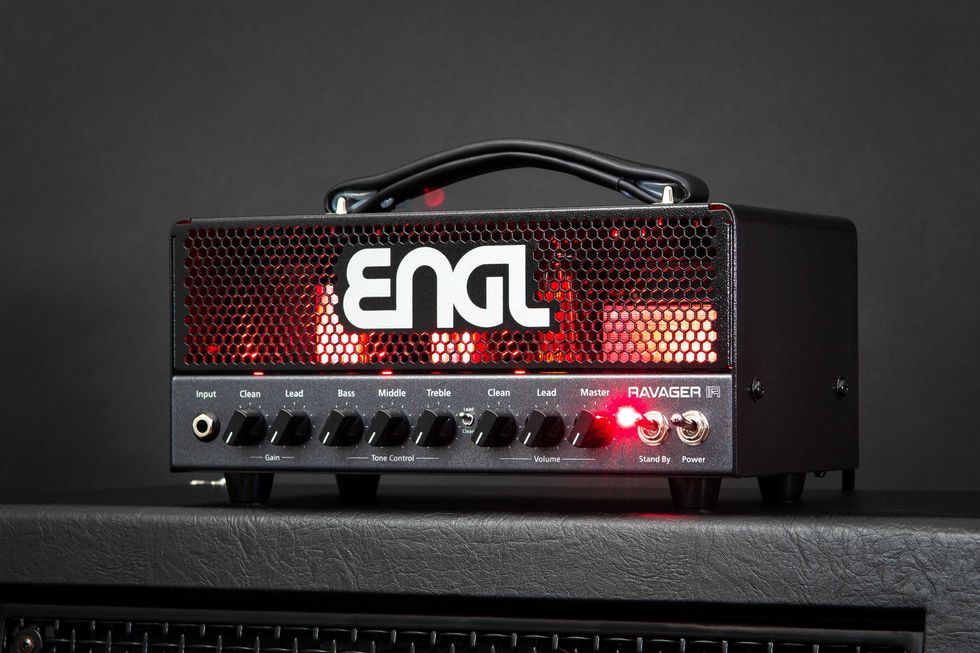
Key Features:
- 20W, 2-channel tube amp
- ECC83 preamp & EL84 power amp section for authentic tone
- Built-in IR Loader with four Irs (three customizable slots)
- USB connectivity for easy IR management
- Headphone output for silent practice
- XLR direct output for live and recording setups
- Integrated Power Soak for adjustable power (20 Watts, 5 Watts, 1 Watts, Speaker off) ∙ Compact, portable lunchbox design
E412XXLK Eminence Karnivore
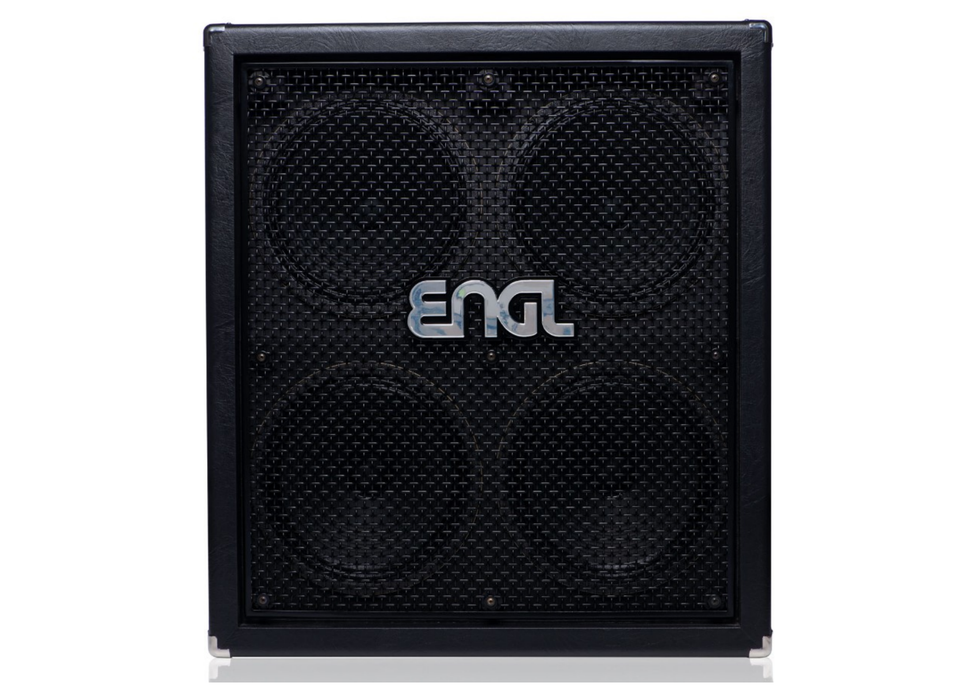
Engl unveils the new E412XXL with Eminence Karnivore speakers — a powerhouse 4x12"cabinet built to meet the demands of modern high-gain players. This updated version of the legendary E412XXL combines Engl’s precision-engineered oversized enclosure with the aggressive tonal character of the Eminence Karnivore speakers, delivering bone-crushing low end,razor-sharp attack, and exceptional clarity at high volumes.
Features
- Four Eminence Karnivore 12" Speakers
- Designed for modern metal and hard rock, offering tight bass, cutting mids, and controlled top end for maximum definition under high gain.
- Oversized Straight Cabinet Design
- Deep enclosure for massive low-frequency response and room-filling projection.
- High Power Handling
- 240-watt total power at 8 ohms, ready to handle the most powerful tube heads without breaking a sweat.
- Tour-Grade Construction
- Robust birch plywood build, reinforced corners, metal grille, and heavy-duty casters for reliable road use.
- Huge, crushing sound ideal for drop tunings and extended-range guitars ∙ Precise articulation at high volumes for tight rhythm work
- Designed from the ground up by Kristian Kohle and the Eminence engineering team, the Karnivore delivers all the bite and all the meat
Availability
The new E412XXL with Eminence Karnivore is available hrough authorized Engl dealers and distributors worldwide.
Rig Rundown: My Chemical Romance
After their Covid-delayed, smash-success reunion tour a few years back, My Chemical Romance plotted the Long Live the Black Parade North American stadium tour this past summer.
PG’s Chris Kies joined the run at Soldier Field in Chicago, and before the show, he rendezvoused with techs James Bowman, Josh Schreibeis, and Joe Saucedo—who handle Frank Iero, Ray Toro and Mikey Way’s rigs, respectively—for a look at the axes, amps, and effects the heavy-hitting emo titans are using these days.
Brought to you by D’Addario.
Dose of Castedosa
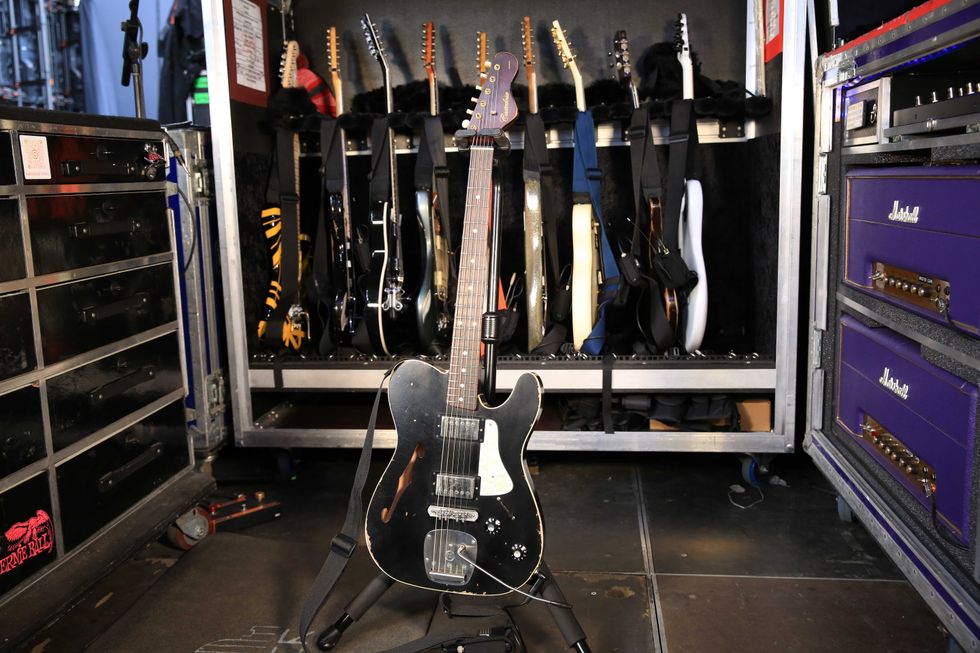
After Iero got this Castedosa Marianna Semi Hollow, it became the show starter for this summer’s tour. This, and all other guitars, are tuned down a half step with Ernie Ball Paradigm strings (.011–.052).
Bury Me in White
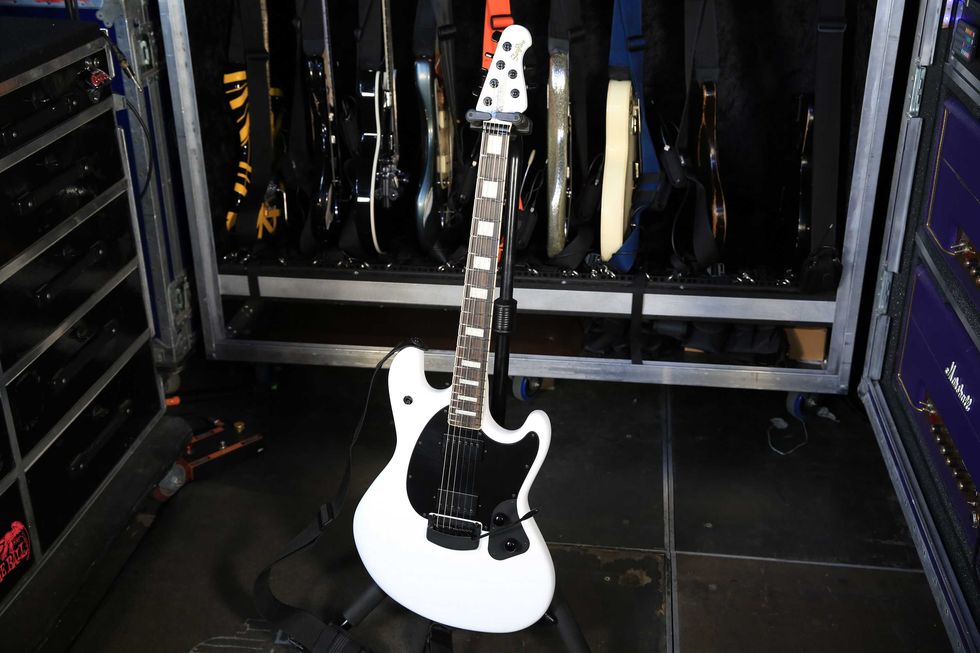
Iero favors Ernie Ball StingRays like this one, in matte “Stormtrooper” white. The only mod on this guitar is the addition of Luminlay dots on the side of the neck.
One and Done
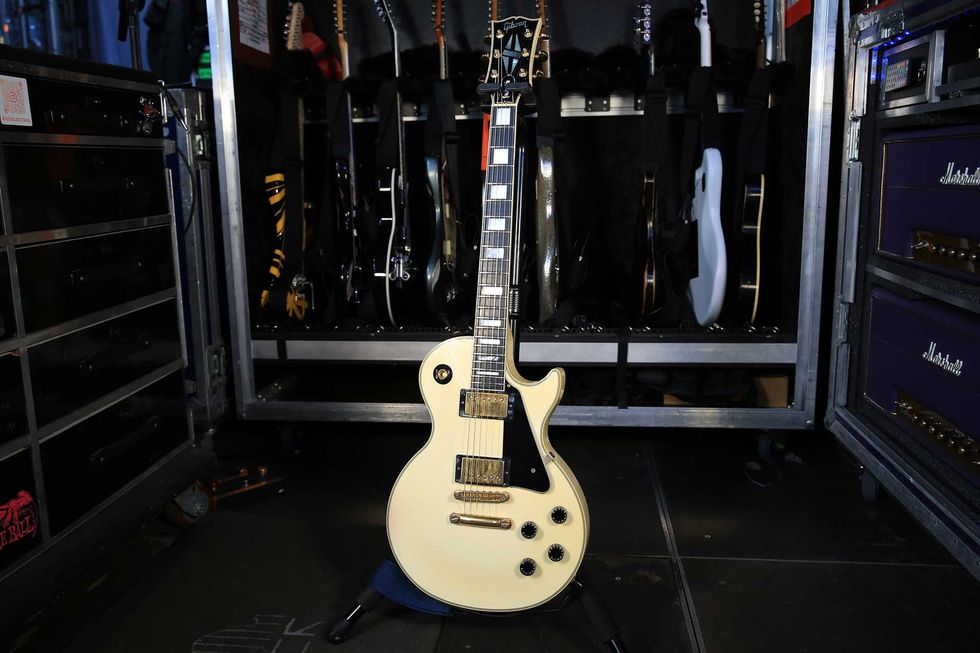
This 1992 Gibson Les Paul gets played only for the title track off the band’s 2006 record, The Black Parade.
Under Pressure
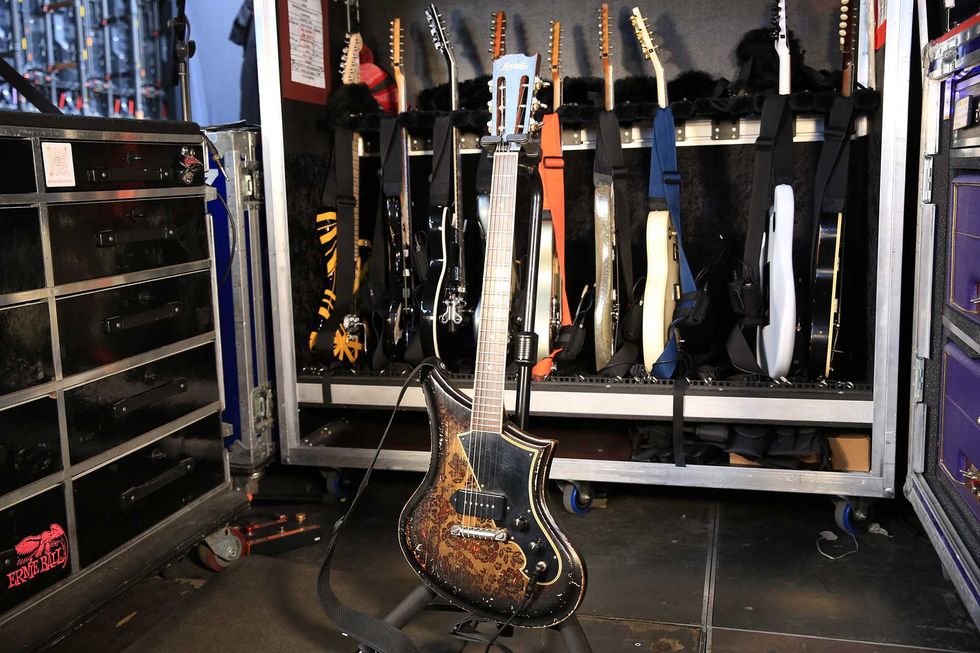
This tiny, light Abernethy Guitars electric takes Bowman forever to string. If anyone has tips, send them his way.
Purple Reign
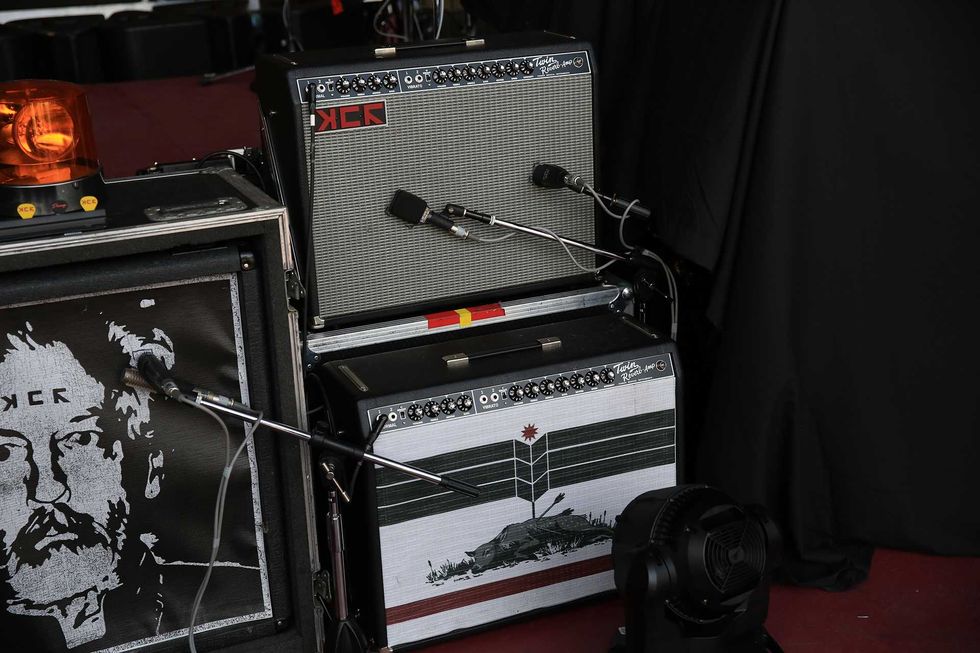
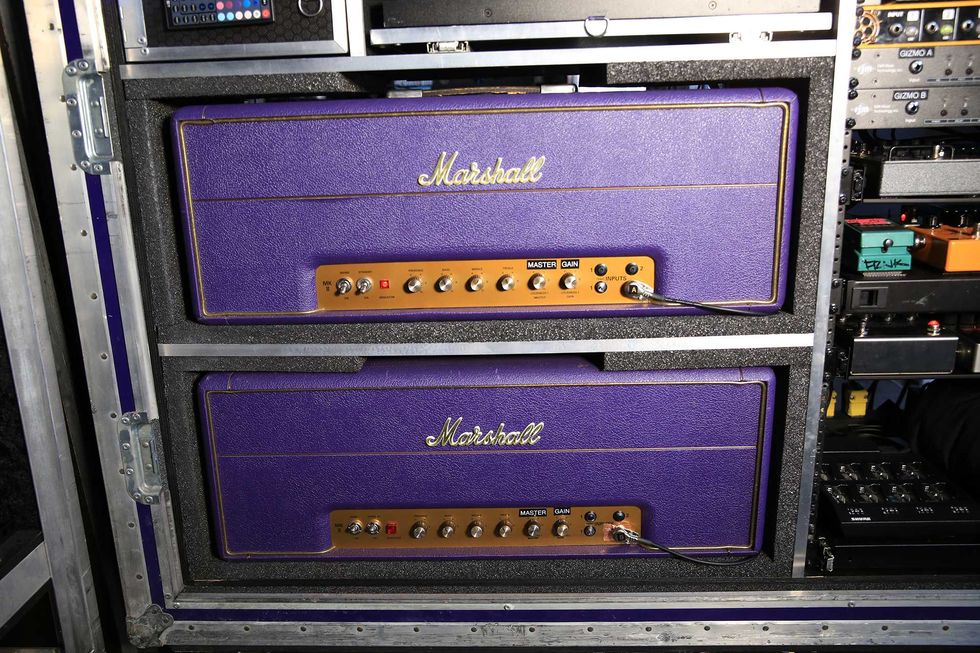
After using Marshall Super Lead heads with the Dookie mod on the previous tour, Iero found these slick purple heads and brought them to Dave Friedman to match the Dookie specs and add some EQ tweaks. These two, a main and backup, are responsible for the bulk of Iero’s sounds.
A Fender Twin Reverb onstage is responsible for “small-amp sounds,” while a Twin Reverb Tone Master underneath it sends a clean DI signal for the mix in Iero’s in-ear monitors.
Welcome to the Rack Parade
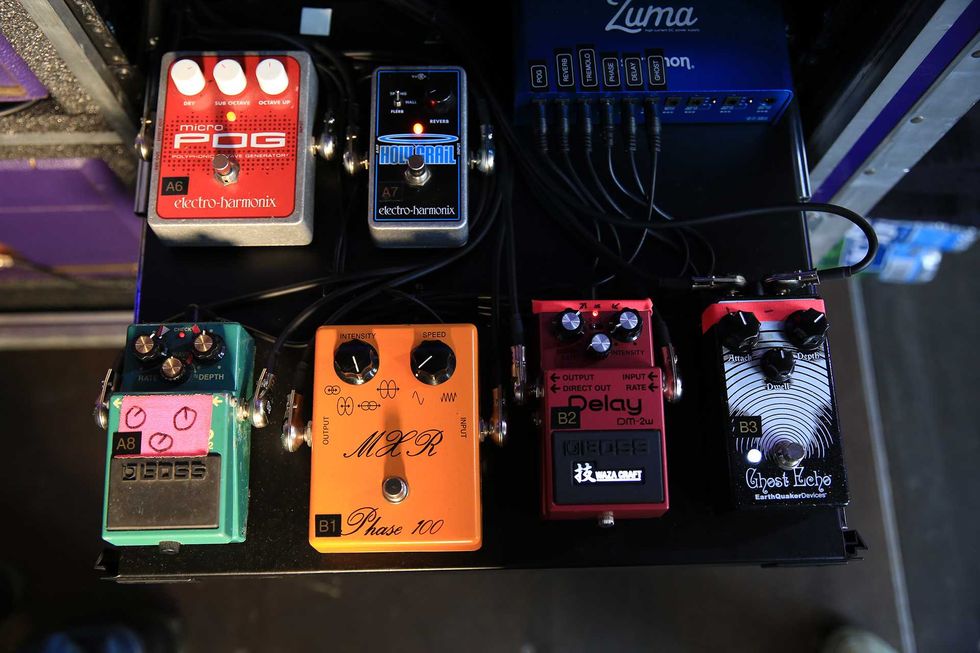
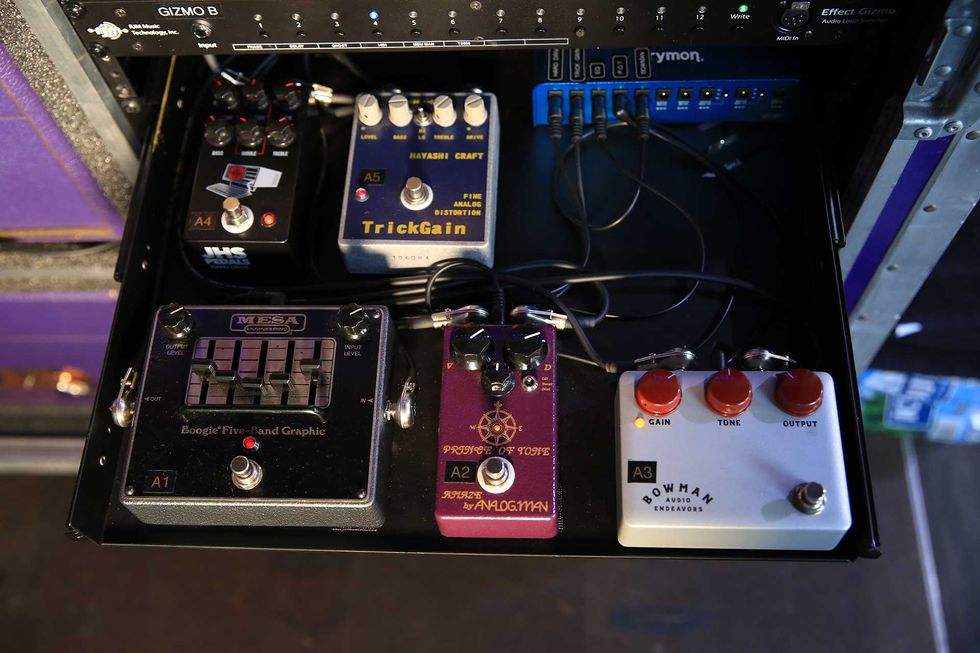
Iero’s backstage rack includes three main racks of effects, all powered by Strymon Zumas.
The first carries a Mesa Boogie 5-Band Graphic EQ, Amaze by Analogman Prince of Tone, Bowman Audio Endeavors Bowman Overdrive, JHS Hard Drive, and Hayashi Craft Trick Gain.
Drawer two is about modulation, and includes a Boss TR-2, MXR Phase 100, Boss DM-2W, EarthQuaker Devices Ghost Echo, EHX Micro POG, and EHX Holy Grail.
The last drawer bears a Jackson Audio Twin Twelve, EHX Deluxe Memory Man, Ibanez Tube Screamer Overdrive Pro, and Bowman Audio Bellyacher.
Toro’s Top
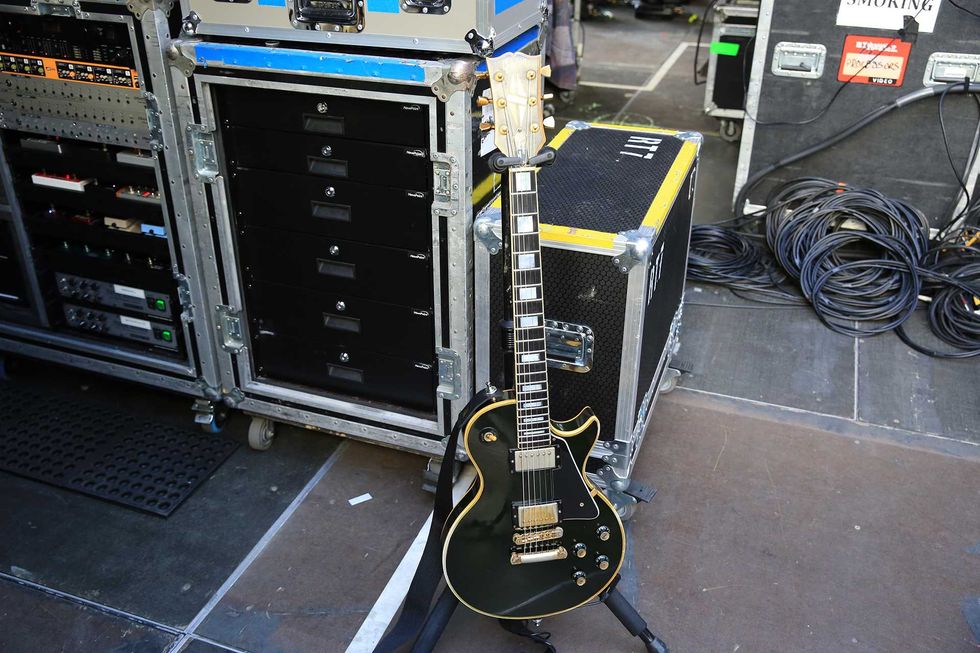
Toro plays this 1978 Les Paul to start the show, including tracks “The End.,” “Dead!,” and “House of Wolves.” He runs .011–.052-gauge strings on all his guitars.
Second Fiddle
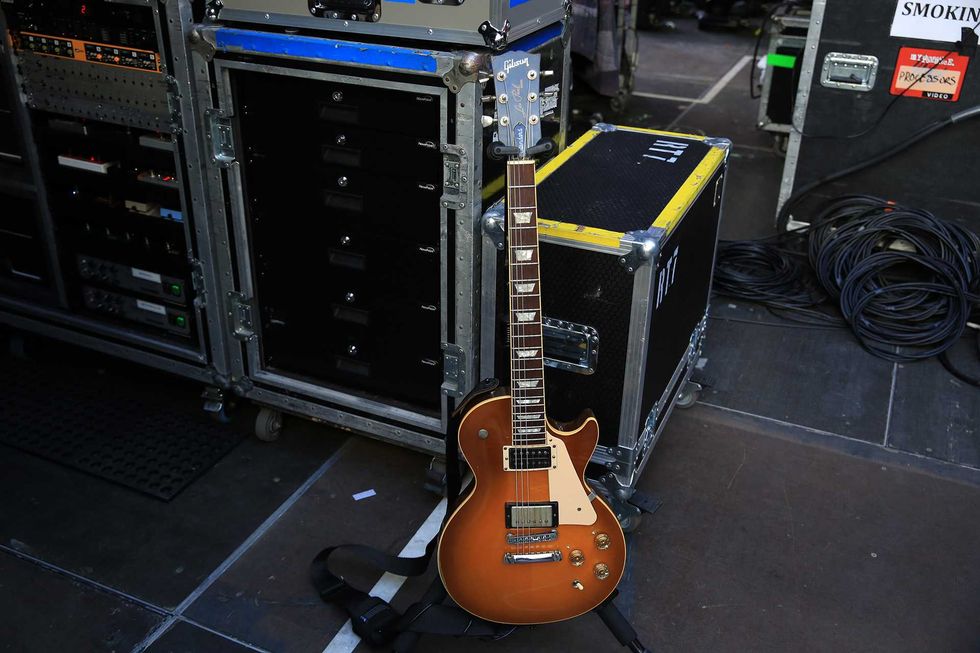
This sunburst Les Paul has been outpaced by the black ’78, but it still comes out for “Welcome to the Black Parade” and “Famous Last Words.”
Super 6
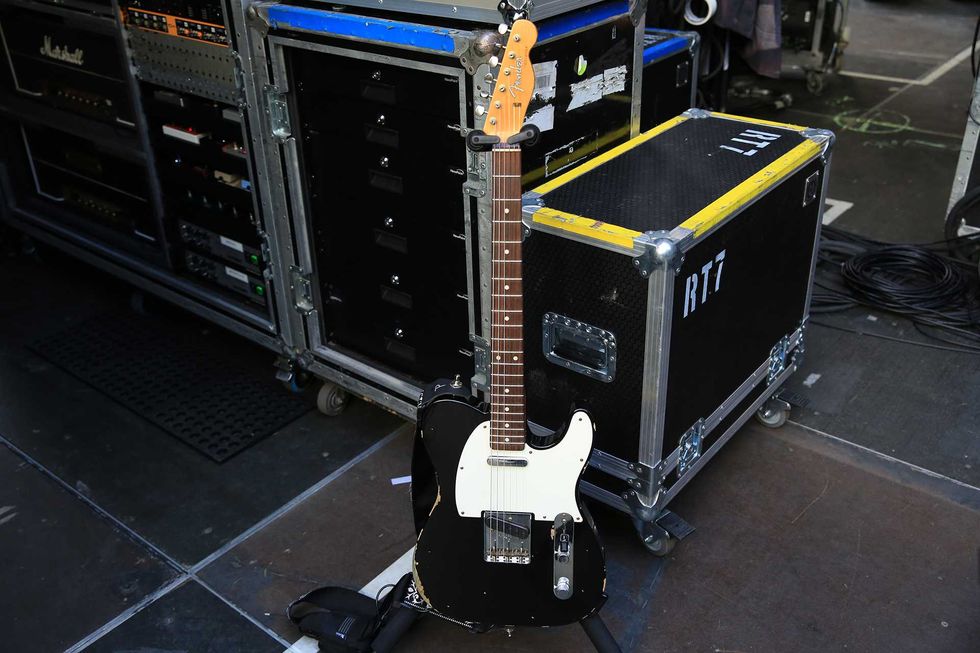
This 2005 Fender Custom Shop Telecaster sees action on six tunes in the band’s set.
Ray Toro’s Amps
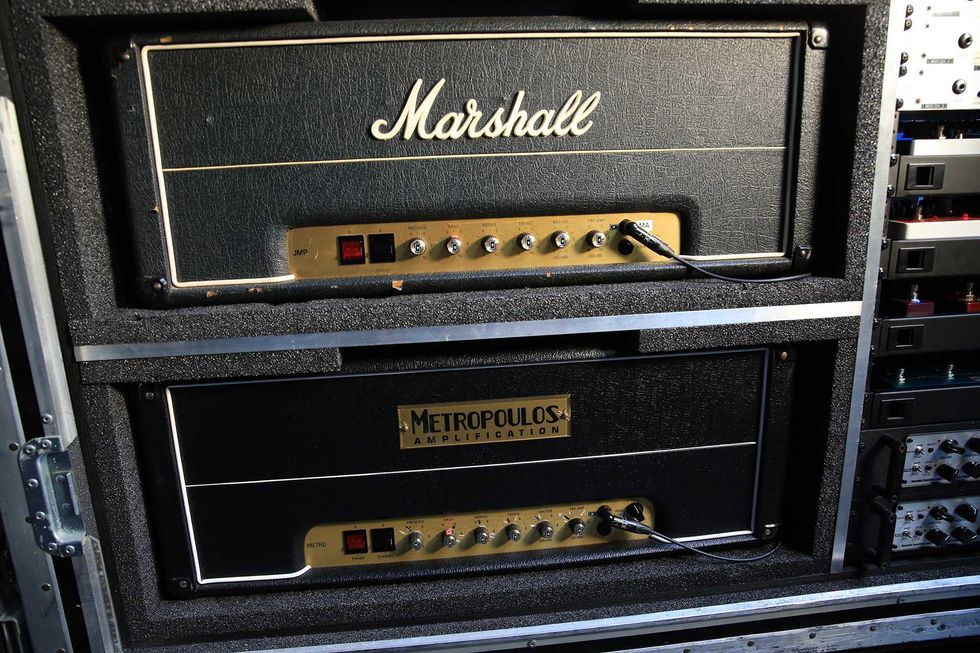
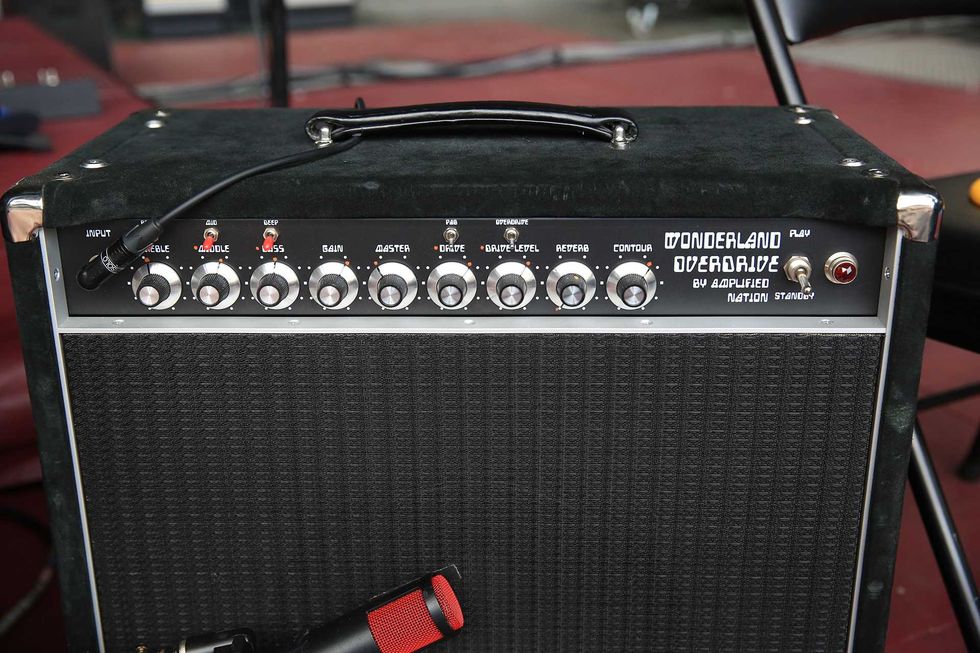
A head combo of a Marshall JMP and Metropoulos Amplification Metro (both running into Fryette PS-100s) comprise Toro’s main tones, while an Amplified Nation Wonderland Overdrive 1x12 combo is used for solo sounds, and a Fender Deluxe Reverb handles cleans. Toro’s signal is pumped through two 4x12 cabs—one Marshall, one Bad Cat.
Ray’s Really Rockin’ Rack Rig
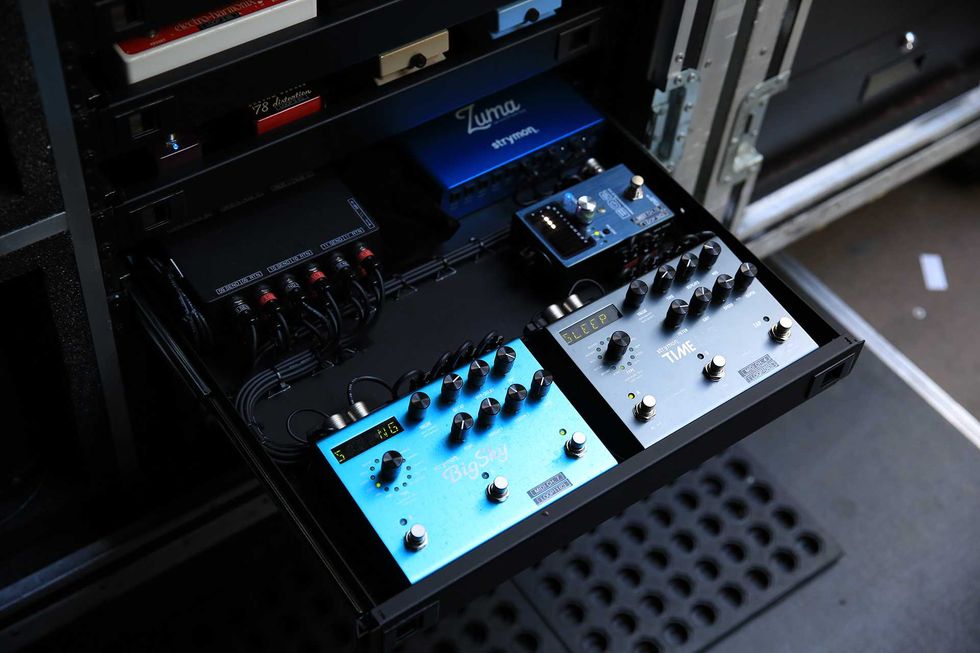
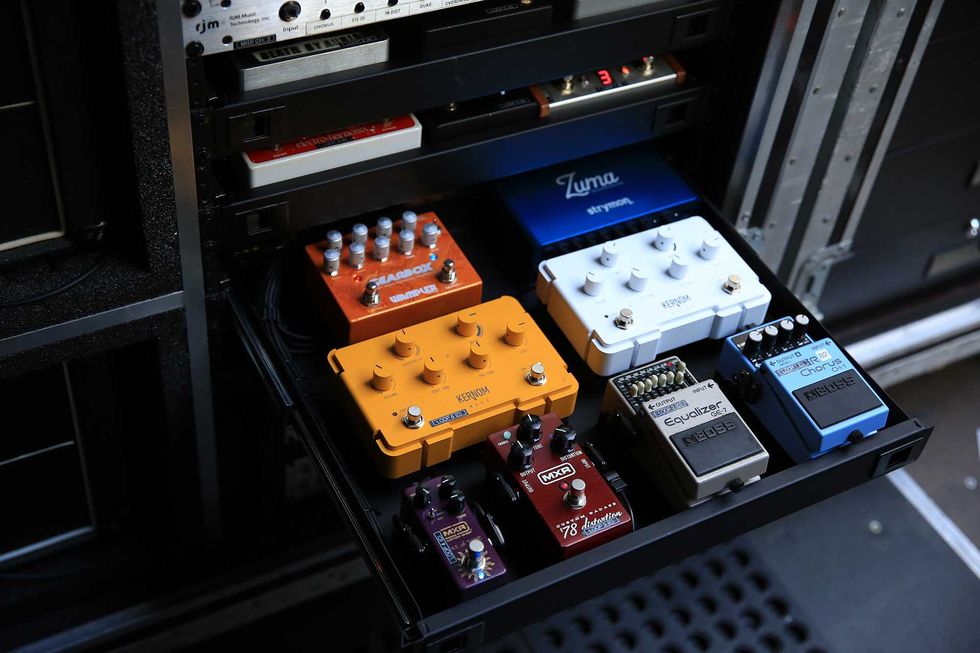
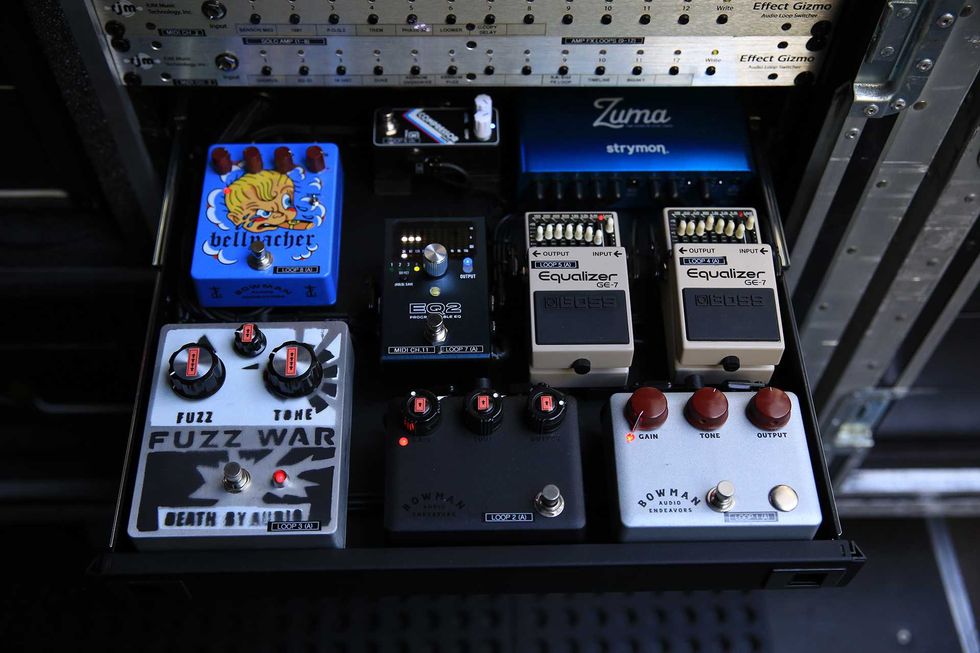
A Shure Axient wireless system sends his guitar’s signal to this system backstage, where it hits a Radial JX44 and a pair of RJM Effect Gizmos.
One drawer holds an MXR Duke of Tone, MXR Custom Badass ’78 Distortion, Boss GE-7, Boss CH-1, Kernom Moho, Kernom Ridge, and Wampler Gearbox.
In the next are two Boss GE-7s, two Bowman Overdrives, a Death by Audio Fuzz War, a Source Audio EQ2, a Bowman Bellyacher, and a Keeley Compressor Mini.
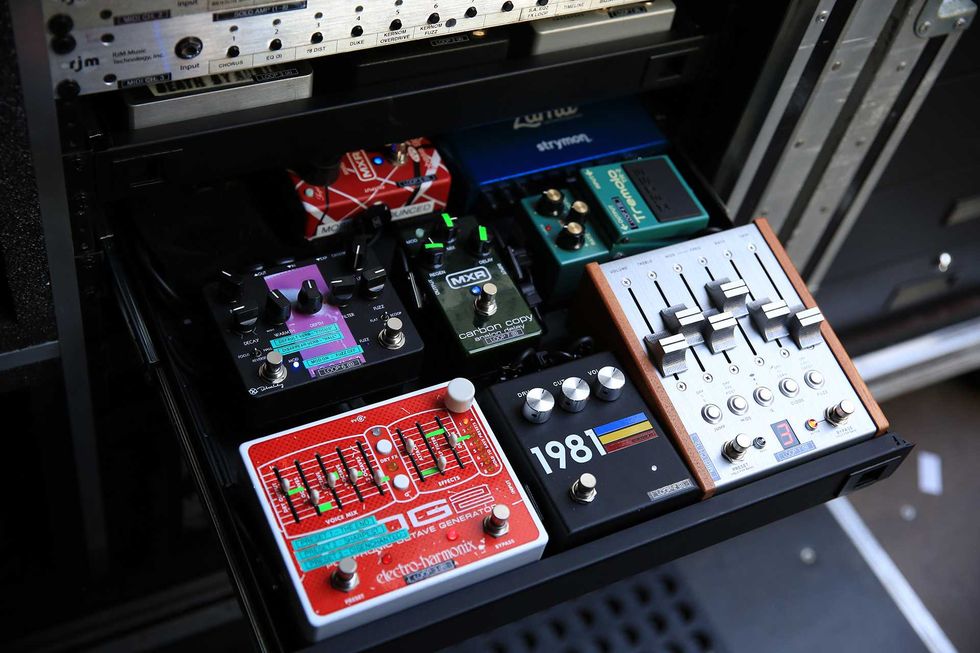
The third shelf is home to an EHX POG2, 1981 Inventions DRV, Chase Bliss Preamp MK II, Boss TR-2, MXR Carbon Copy, Keeley Loomer, and MXR EVH Phase 90.
A fourth level hosts a Strymon TimeLine, Strymon BigSky, and Source Audio EQ2.
Out onstage at his feet, Toro keeps a pedalboard with a TC Electronic PolyTune, a custom RJM Mastermind PBC/6X, Ibanez TS808, Bowman Audio Bowman Overdrive, EHX Micro POG, Boss TR-2, MXR Carbon Copy, and Strymon BigSky.
Strymon Zumas keep everything chugging along.
Comeback Kid
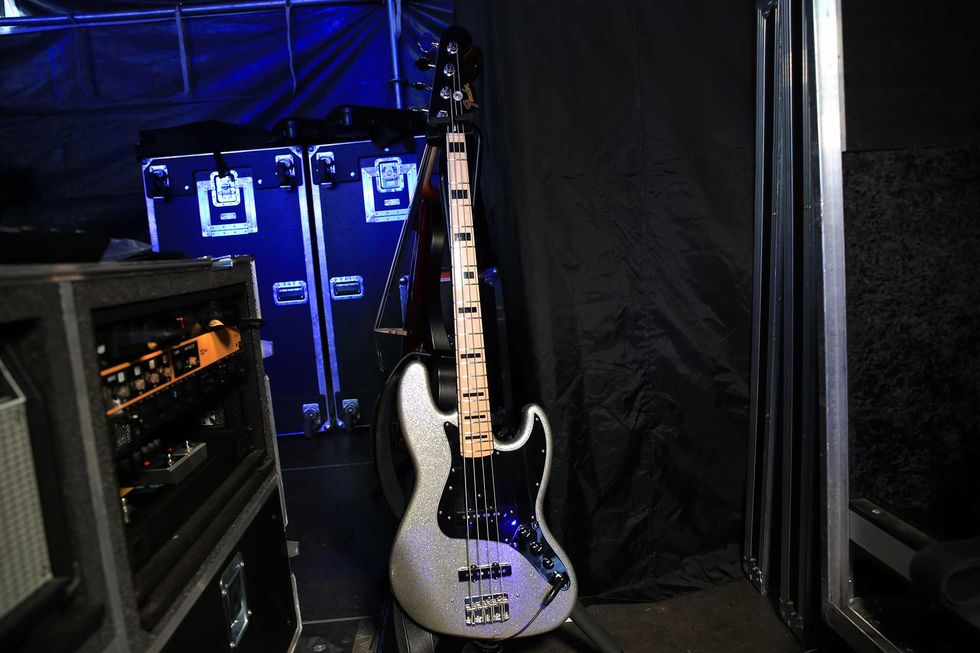
This silver-sparkle Fender Jazz bass was built for the band’s reunion tour, intended to mimic Way’s earlier signature model. It’s since been treated to more affordable Mexico-made production runs. Way runs Ernie Ball Hybrid Slinky strings (.045–.105) and plays with Clayton triangle picks.
Red!
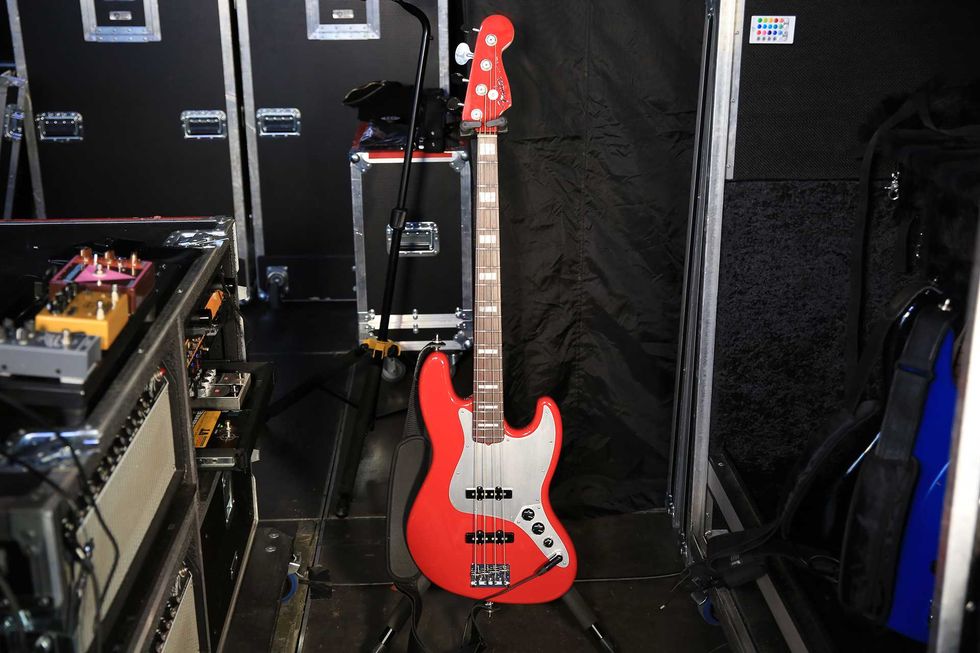
This eye-catcher was made by Fender’s Brian Thrasher, and is equipped with pickups from the Adam Clayton signature bass. Way relies heavily on this one, then switches to an identical one for down tunings.
Dodger That
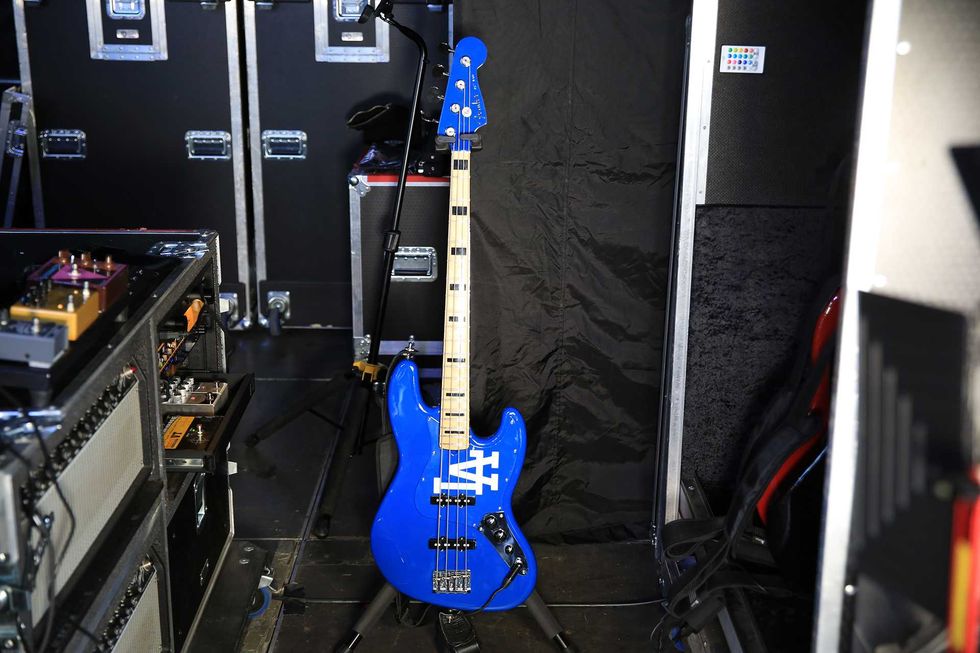
Way secured permission from Major League Baseball and the Los Angeles Dodgers to use the team’s exact hue of blue on this custom instrument.
Mikey Way’s Amp
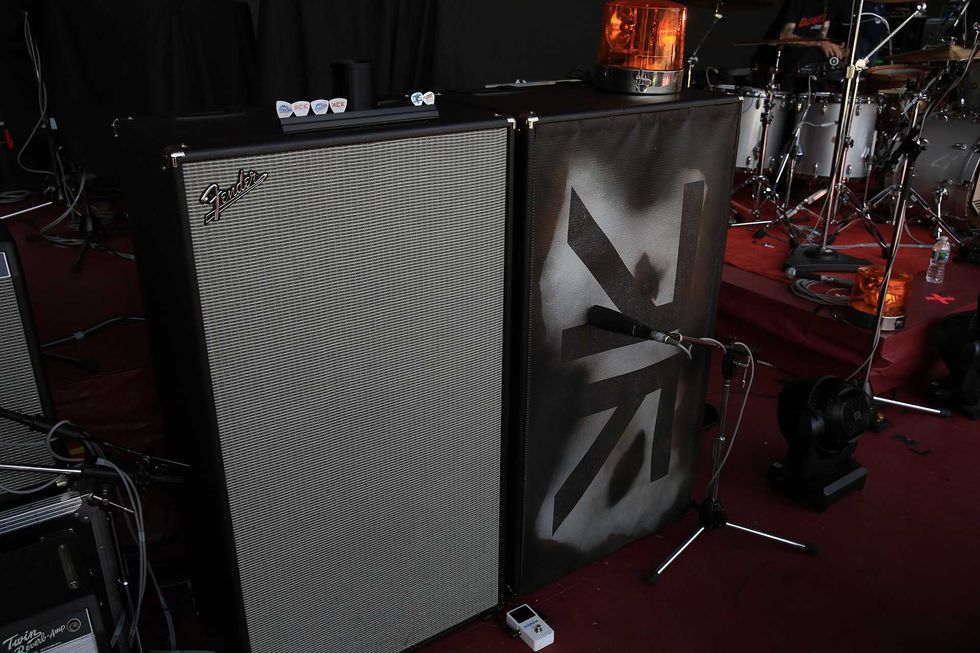
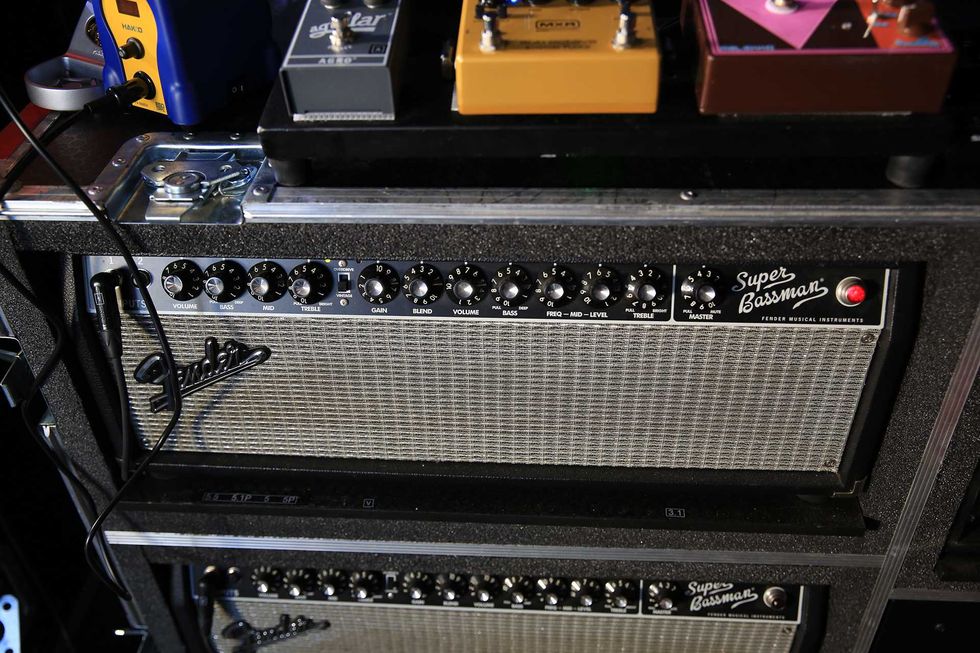
Way runs through a Fender Super Bassman head into matching 8x10 cabs, with a DI signal also running to front of house.
Mikey Way’s Effects
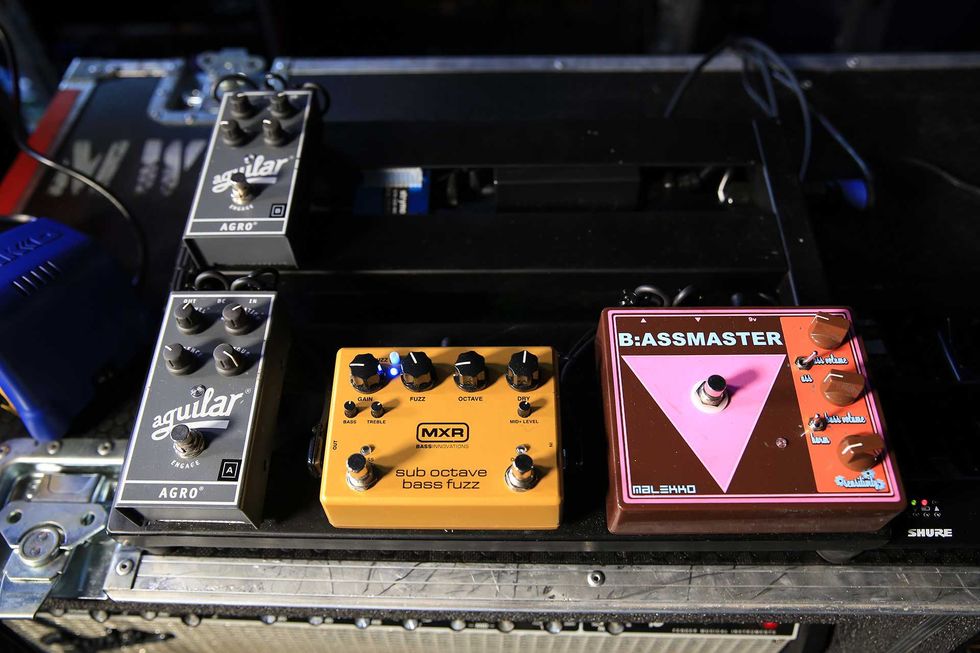
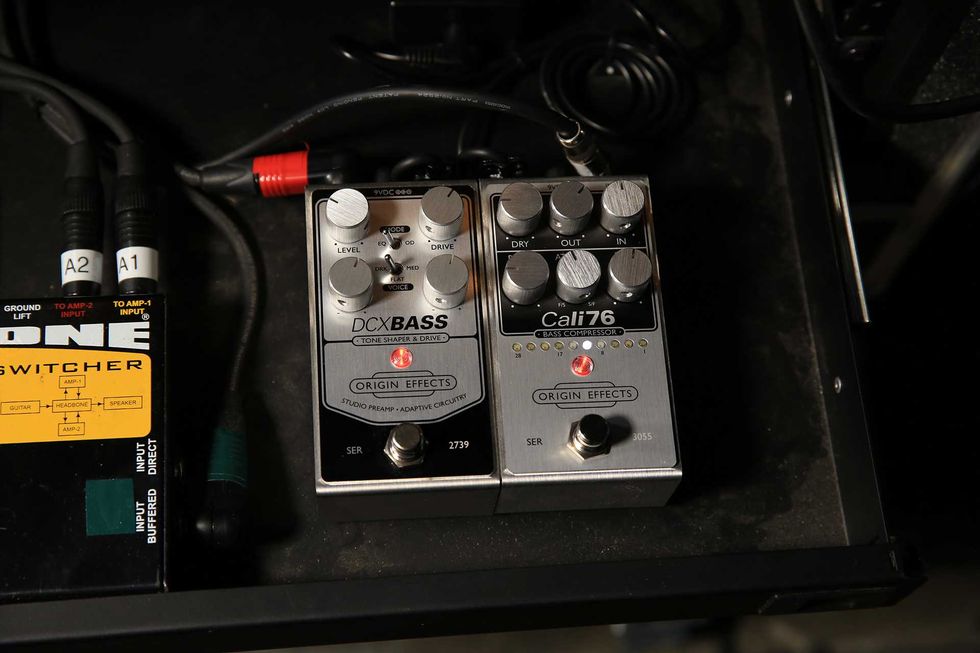
Way keeps things simple. Along with an Origin Effects DCX Bass and Cali76 set to push his Super Bassman, his setup includes a pair of Aguilar Agros, an MXR Sub Octave Bass Fuzz, and a Malekko B:assmaster.
Rattlesnake Cable Company Launches Custom Cable Looms
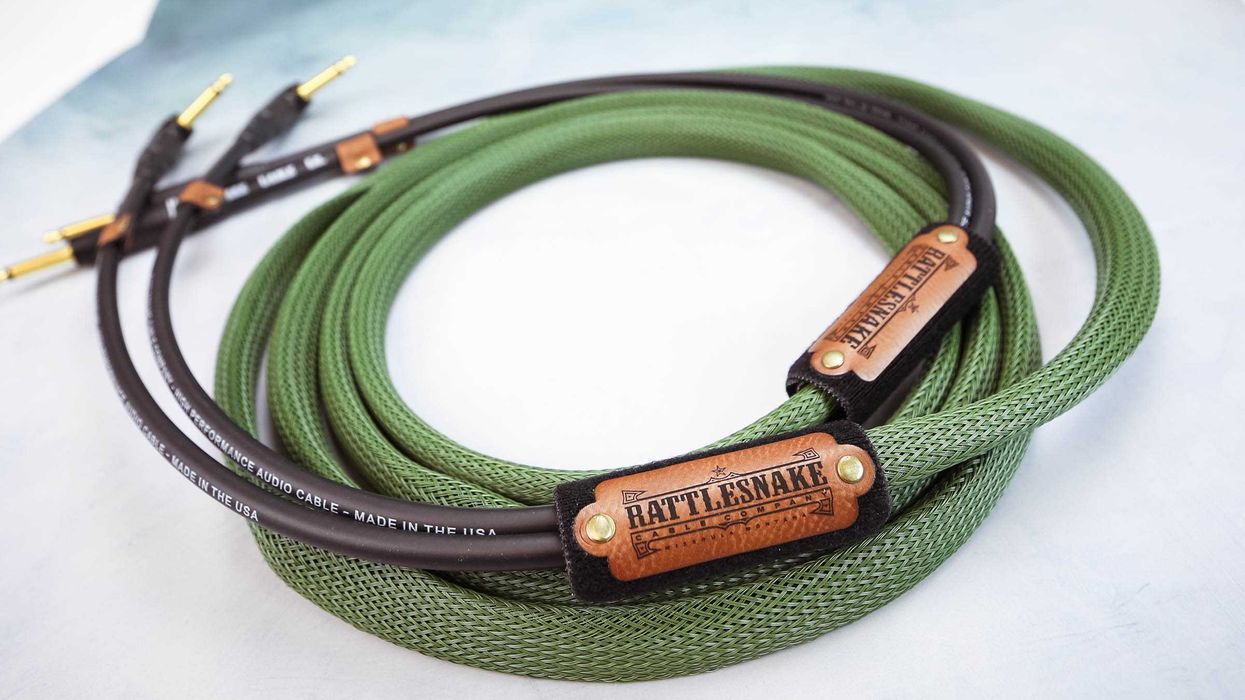
Rattlesnake® Cable Company, renowned for its high-quality, handcrafted instrument cables and audio gear, proudly announces the official launch ofits Custom Cable Looms. Designed for musicians, studios, and audio professionals, theselooms deliver an organized, reliable, and performance-ready solution that transforms theway rigs are set up and used.
What Is a Custom Cable Loom?
Rattlesnake’s Custom Cable Looms are handcrafted bundles that combine multiple cables intoa single, consolidated harness - tailored to the customer’s exact setup. Each loom is carefullymeasured, built, and wrapped in our signature rugged weave, ensuring clarity in the studio,confidence on stage, and unmatched durability.“Custom cable looms are about more than organization - they’re about elevating theprofessional experience for musicians and engineers,” said Hank Donovan, founder ofRattlesnake® Cable Company. “By streamlining setup, reducing clutter, and guaranteeingreliable connections, our looms give artists peace of mind so they can focus fully on their craft.”
Benefits of Rattlesnake® Custom Cable Looms:
- Efficiency & Speed – Faster setup and teardown with perfectly measured, consolidatedcables.
- Professional Presentation – Clean, organized rigs that look as good as they sound.
- Durability & Reliability – Premium U.S.-milled cables, hand-assembled in Missoula,Montana.
- Tailored Design – Each loom is built one at a time to match the customer’s exact rigneeds.
- Reduced Cable Clutter – Simplifies routing and reduces wear on gear.
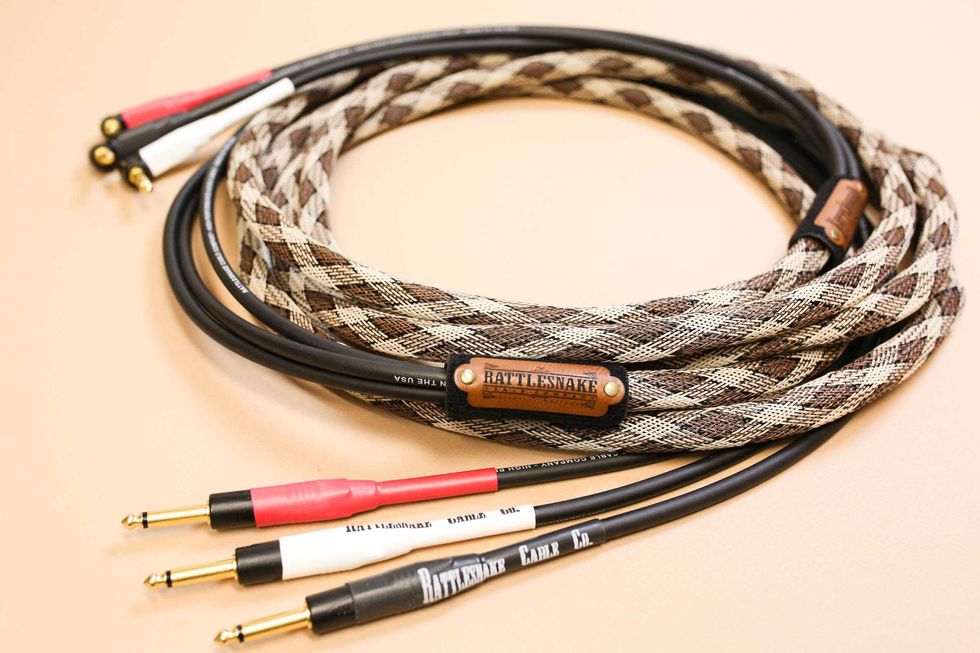
Each loom is a collaboration between Rattlesnake and the customer, ensuring measurements and connections are designed specifically for their unique configuration. This personalized build process reinforces the company’s mission: craftsmanship at the core, confidence in every connection.
Availability
Rattlesnake® Custom Cable Looms are available now and can be ordered directly through the company’s website. Pricing is based on customer specifications, with consultations available for musicians and studios seeking the perfect solution.
View more and request your custom loom here: https://www.rattlesnakecables.com/custom-looms/
Stompboxtober 2025: Keeley Electronics
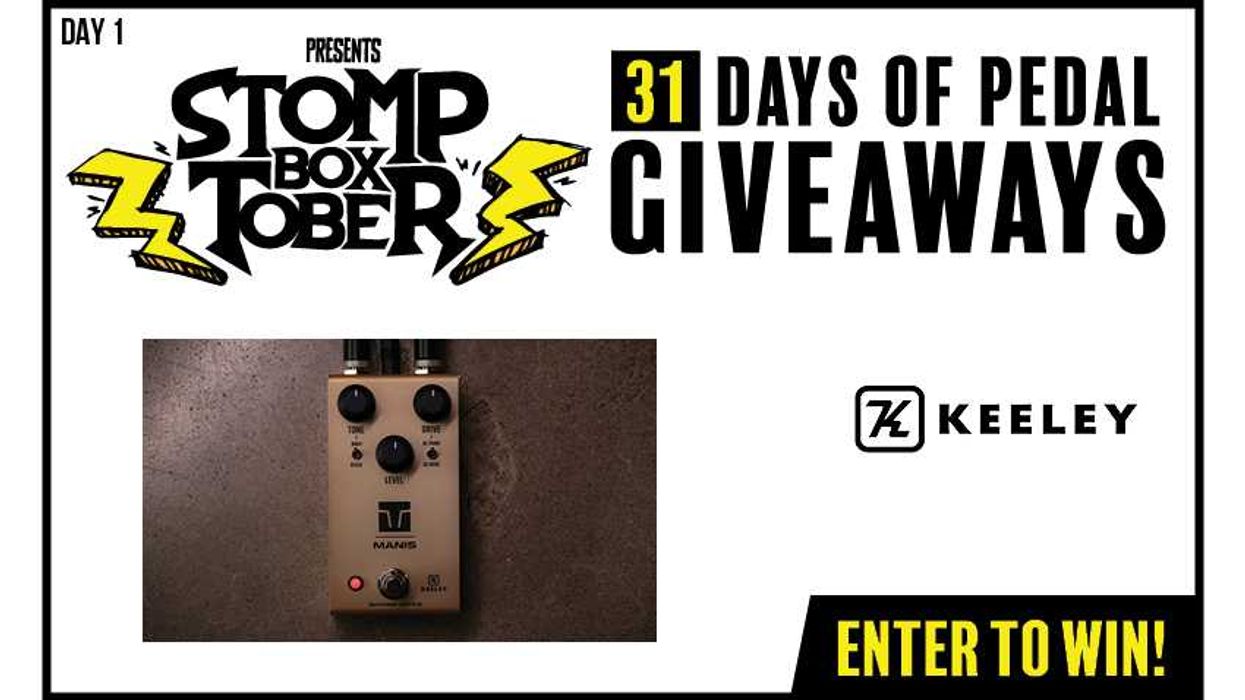
Stompboxtober is back for 2025! Come back all month long for your chance to WIN daily pedal giveaways. Today's giveaway is the Keeley MANIS Overdrive!
Stompboxtober 2025 - Win Pedals All Month Long!
Keeley Electronics MANIS Overdrive
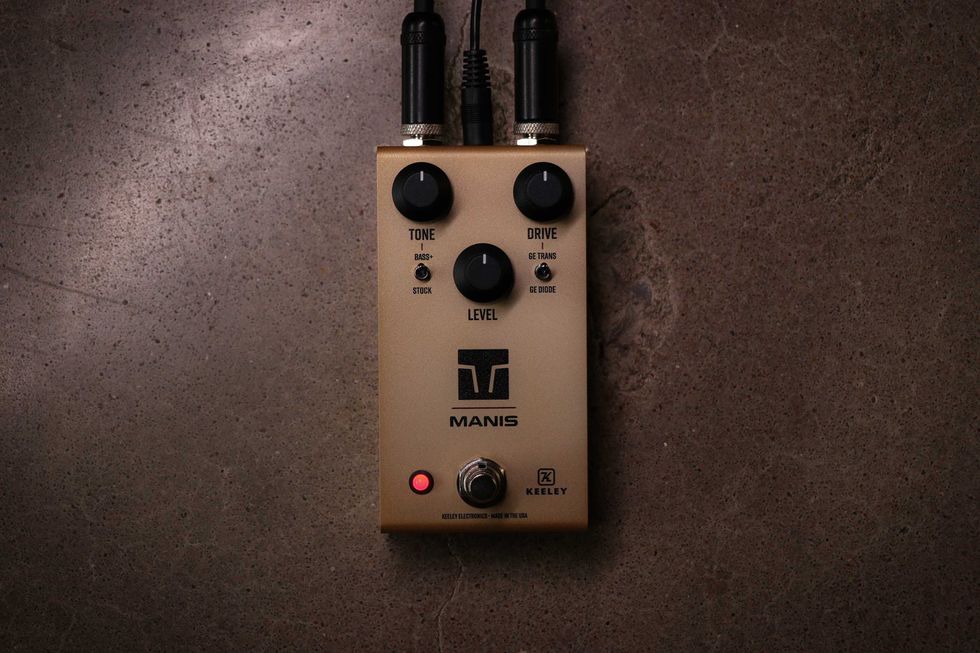
The Keeley MANIS Overdrive is a bold evolution of the mythical transparent drive, blending NOS germanium transistors and diodes for unmatched warmth, compression, and grit. With switchable voicings and dynamic touch response, it’s a tone-sculpting weapon built for players who demand both clarity and rich harmonic character in one pedal.
Price : $199.00

Keeley Manis Overdrive Pedal
The Fearless Flyers: Flight School is in Session!
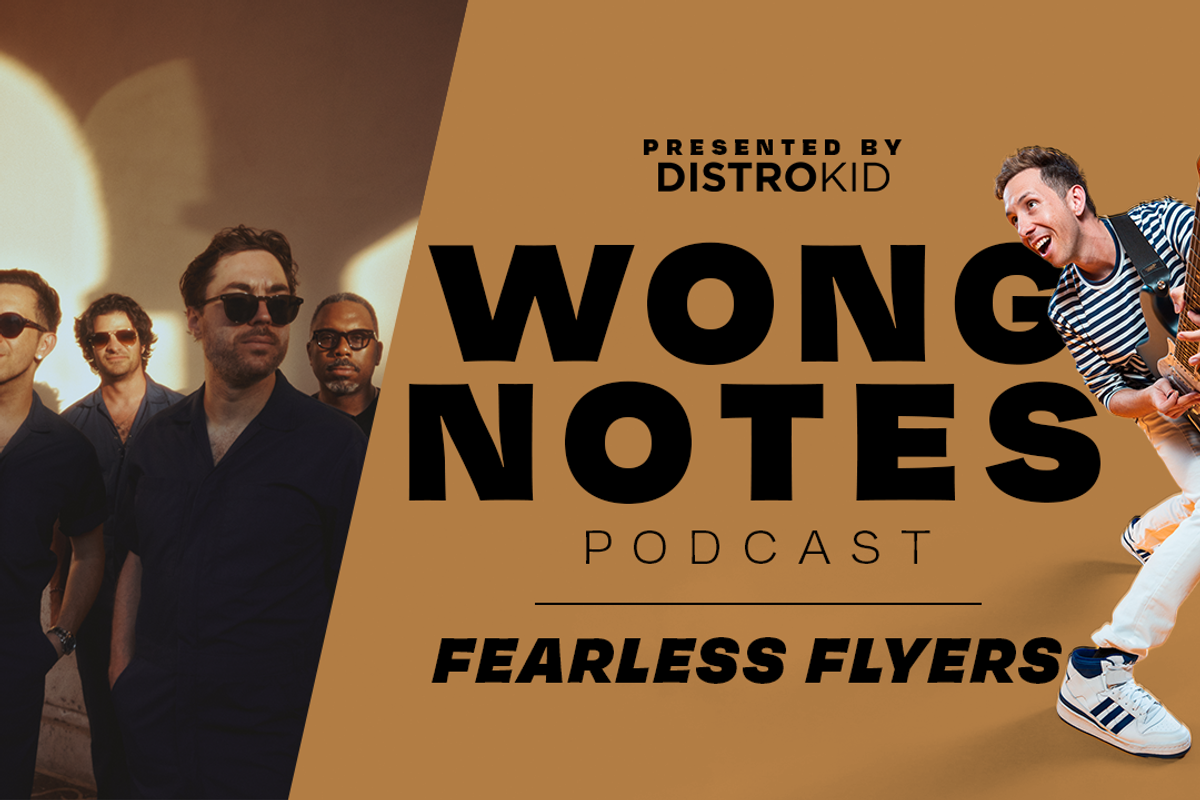
Welcome back for a special episode of Wong Notes! If you couldn’t make it to Cory’s Syncopated Summer Camp, this one’s for you: It features Wong and his Flyers bandmates—Nate Smith on drums, Joe Dart on bass, and Mark Lettieri on guitar—in a live masterclass recording from this summer, as they jam and break down an original composition.
The group starts off with a rowdy rip through the tune (which, apparently, didn’t go so well when they played it in Italy) before slowing down its constituent parts and highlighting Lettieri’s thoughtful arrangements. Each member of the band takes a turn explaining their approach to jamming and improvising—and how to know when trouble is coming. (For Smith, it’s when one player tries to “force an agenda.”)
The most important instrument for a successful jam and songwriting session? Your ears: It all comes back to listening. So listen in and learn with the best on this exclusive instalment.
Prog-Rock Supergroup DarWin Release New Studio Album Distorted Mirror Out Now!

Prog-Rock supergroup DarWin today release their anticipated new studio album, Distorted Mirror, via OoS/Phantom Recordings.
Distorted Mirror, which is co-produced by Simon Phillips and DarWin, is the follow up to last year’s hit release, Five Steps on the Sun, and picks up exactly where the last album left off. Offering original and creative rock songs that continue to break new ground, Distorted Mirror is a true journey, packed with intricate melodies, sledgehammer grooves and wall-to-wall virtuoso playing.

DarWin is an ongoing musical exploration led by songwriter/guitarist DarWin and drumming legend Simon Phillips (Toto, Jeff Beck, The Who, Judas Priest, Tears for Fears). Since forming in 2015, the duo has collaborated with lead vocalist Matt Bissonette (Joe Satriani, Ringo Starr, Elton John), bass sensation Mohini Dey (Steve Vai, Willow Smith, Guthrie Govan), guitarist Greg Howe (Michael Jackson, Protocol, Justin Timberlake) as well as a hall of fame roster of musicians over the years, including Derek Sherinian, Julian Pollack (J3PO), Jesse Siebenberg, Andy Timmons, Billy Sheehan, Guthrie Govan, and many more.
Over the span of the last several months the group have released a vast palette of captivating videos offering both conceptual and live performance as well as a series of guitar and drum playthrough clips that can be viewed HERE.
Watch the official music performance video for “Man vs. Machine” HERE.
An alternative conceptual cut of the “Man vs. Machine” video titled “Dawn of the Robots Version” is also available HERE.
Fans can also watch the official music video for the song “Rising Distortion” HERE.
The Distorted Mirror album tracklisting is as follows:
- Rising Distortion
- Distorted Mirror
- Man vs. Machine
- 33rd Century Man
- Cry a River
- Glow
- Loophole
- Winter Fare
Stream / Share / Purchase the album HERE
What's New: September 30, 2025
Orangewood Clementine: Not Your Average Semi-Hollow! | PG Plays
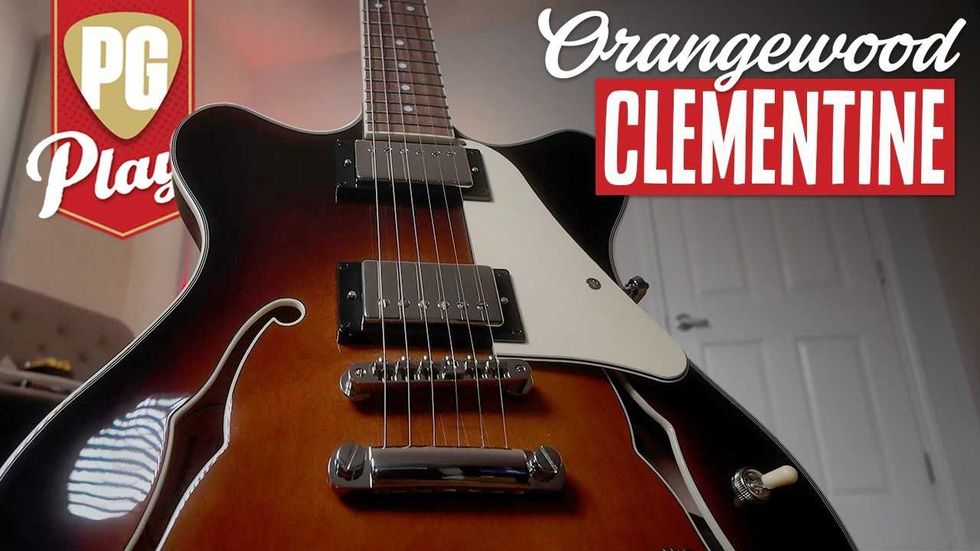
PG contributor Tom Butwin introduces the Clementine from @orangewoodguitars, a semi-hollow guitar that blends classic style with modern functionality. It features a unique belly carve and a satin-finished mahogany neck for enhanced comfort and playability. Equipped with Seymour Duncan Seth Lover humbuckers and a coil split, the Clementine delivers a range of versatile tones. It also includes practical features like an accessible electronics panel and Grover Roto-Grip locking tuners, making it a reliable and easy-to-maintain instrument.
Shop the Clementine in three colors: https://orangewoodguitars.com/pages/c...
Fortin Kali Review
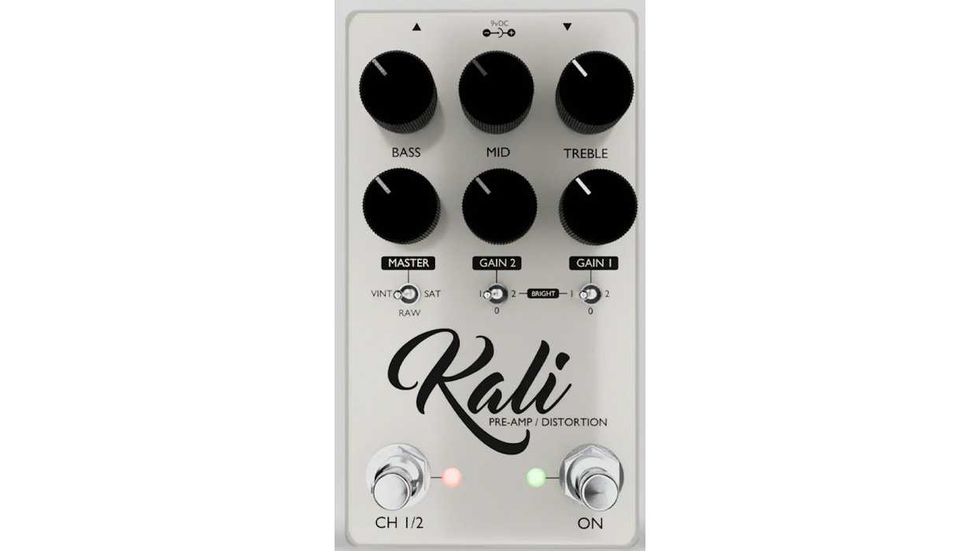
The aptly named Kali distills elements of the Fortin Cali—a Plexi-inspired amp—into a 2-channel pre-amp and distortion pedal. Each channel has three gain modes—vintage, raw, and saturation—which are selectable via a mini toggle. And each mode has a very distinct vibe, which could be loosely categorized as low-end-heavy, midrangey, and high-gain-centric, respectively.
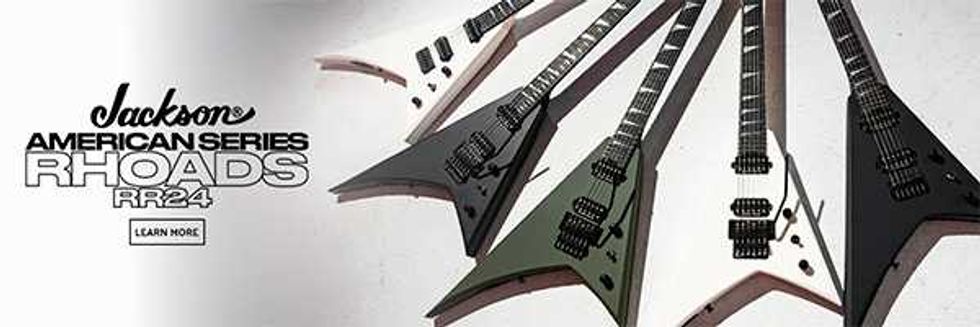
Jimmy Herring: ARU, Panic, and Beyond | 100 Guitarists Podcast
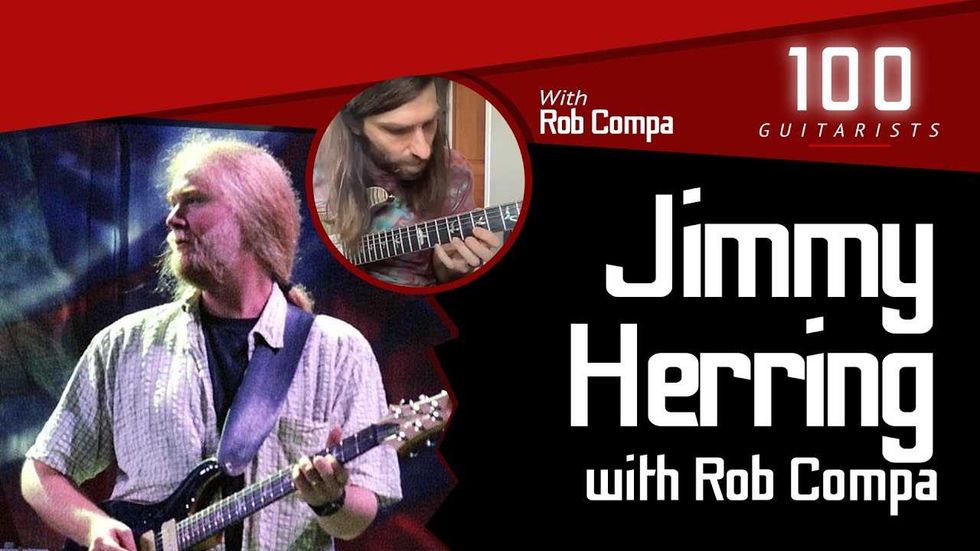
This week, hosts Nick Millevoi and the shamelessly biased Jason Shadrick dive deep—much, much deeper than Nick ever imagined he would go—into the vast discography of the great Jimmy Herring. They enlist Rob Compa, formerly of Dopapod and now of Neighbor, whose greatest qualification is living in Burlington, Vermont, "the hub of all things jam bands".
Sowing in the Storm with "Ecstatic Black Metal" Band Agriculture
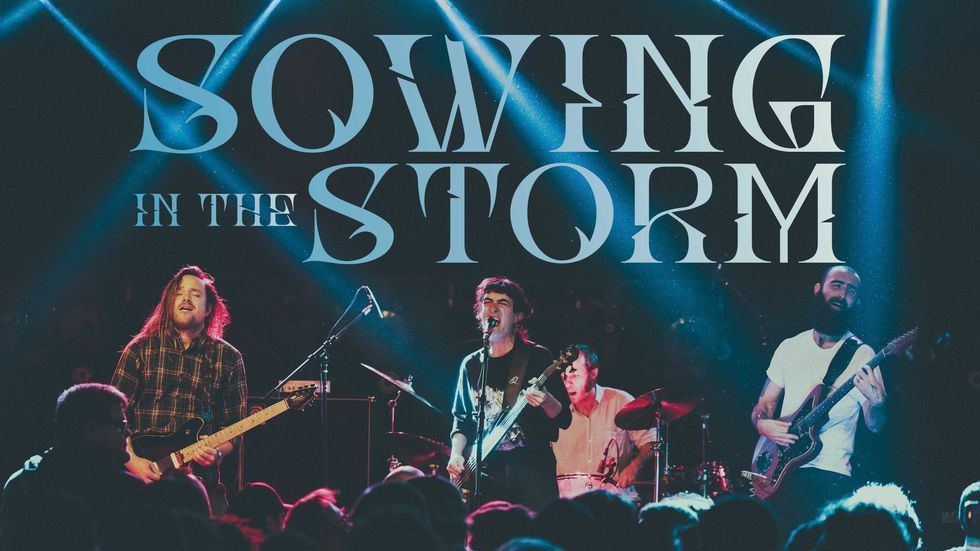
Los Angeles experimental metal band Agriculture’s new record, The Spiritual Sound, might not make sense to you at first listen. When the band sent the album to their friends, many of them were overwhelmed, if not weirded out. The band members weren’t surprised. “If I heard this record for the first time, I’d be pretty confused by it,” says guitarist and vocalist Dan Meyer.
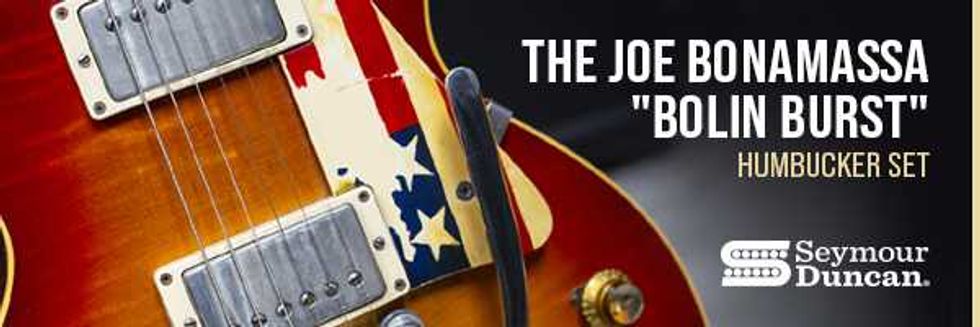
Gear Finds: Pickups and Guitar Upgrades
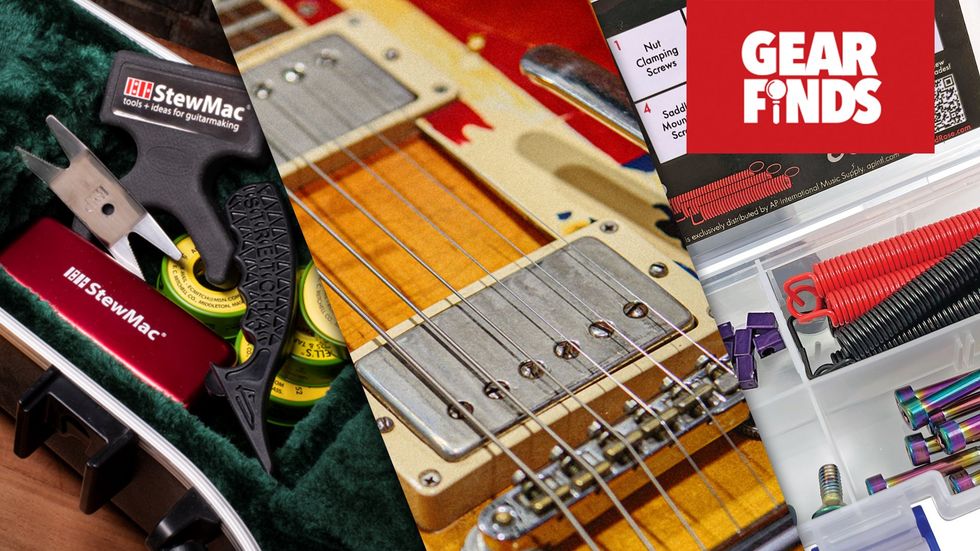
Unlock your guitar's true potential with the Fralin Pickups Push-Pull Blender Pot! Blend tones, split coils, and explore endless sonic possibilities without permanent changes. Ready to elevate your sound? Check out the Joe Bonamassa Humbucker Set and more gear to keep your music alive!
Check Out This Pristine 1959 Les Paul Custom
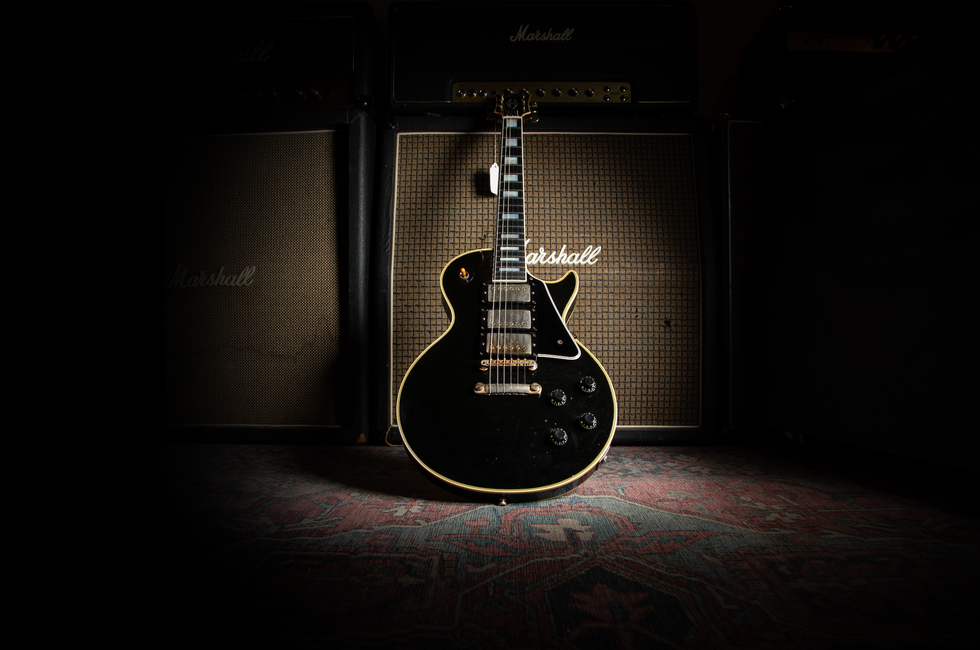
It’s been a minute since we’ve gotten to share something truly special with you all, and today’s subject is one of the finest: a 1959 Gibson Les Paul Custom.
Gibson introduced the first Les Paul Customs in late 1953, following a couple of prototypes built for Les Paul a year earlier. Les wanted what he called a “more elegant” version of the Les Paul Standard, something that looked sharp on the booming new medium of television. His request was specific: a black guitar with refined appointments and design tweaks to match his playing style.
Latest News
Fender Expands Hammertone Series, Introducing New Boost & Breakup Drive
The Music Education Foundation Announces MusicPro ’26
Seymour Duncan Announces The Joe Bonamassa "Bolin Burst" Humbucker Set
Nuno Bettencourt Launches Own Guitar Company, Nuno Guitars
Crazy Tube Circuits Announces Mirage JR
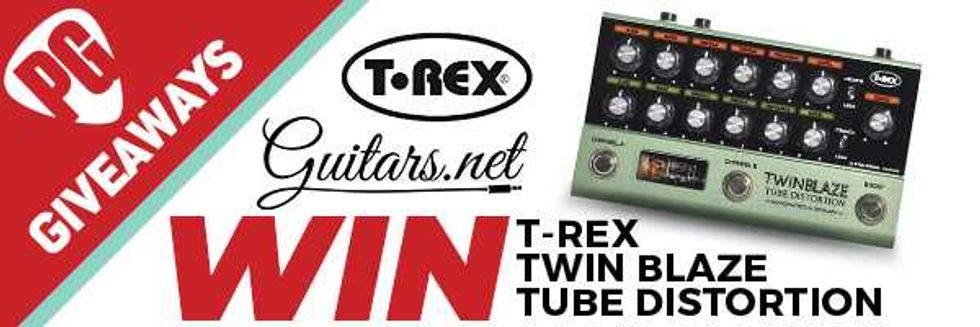
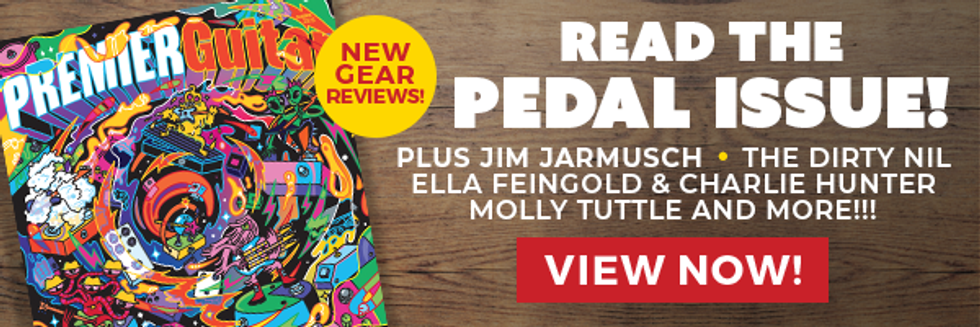
Orangewood Clementine: Not Your Average Semi-Hollow! | PG Plays
PG contributor Tom Butwin introduces the Clementine from @orangewoodguitars, a semi-hollow guitar that blends classic style with modern functionality. It features a unique belly carve and a satin-finished mahogany neck for enhanced comfort and playability. Equipped with Seymour Duncan Seth Lover humbuckers and a coil split, the Clementine delivers a range of versatile tones. It also includes practical features like an accessible electronics panel and Grover Roto-Grip locking tuners, making it a reliable and easy-to-maintain instrument.
Shop the Clementine in three colors: https://orangewoodguitars.com/pages/c...
Fender Expands Hammertone Series, Introducing New Boost & Breakup Drive
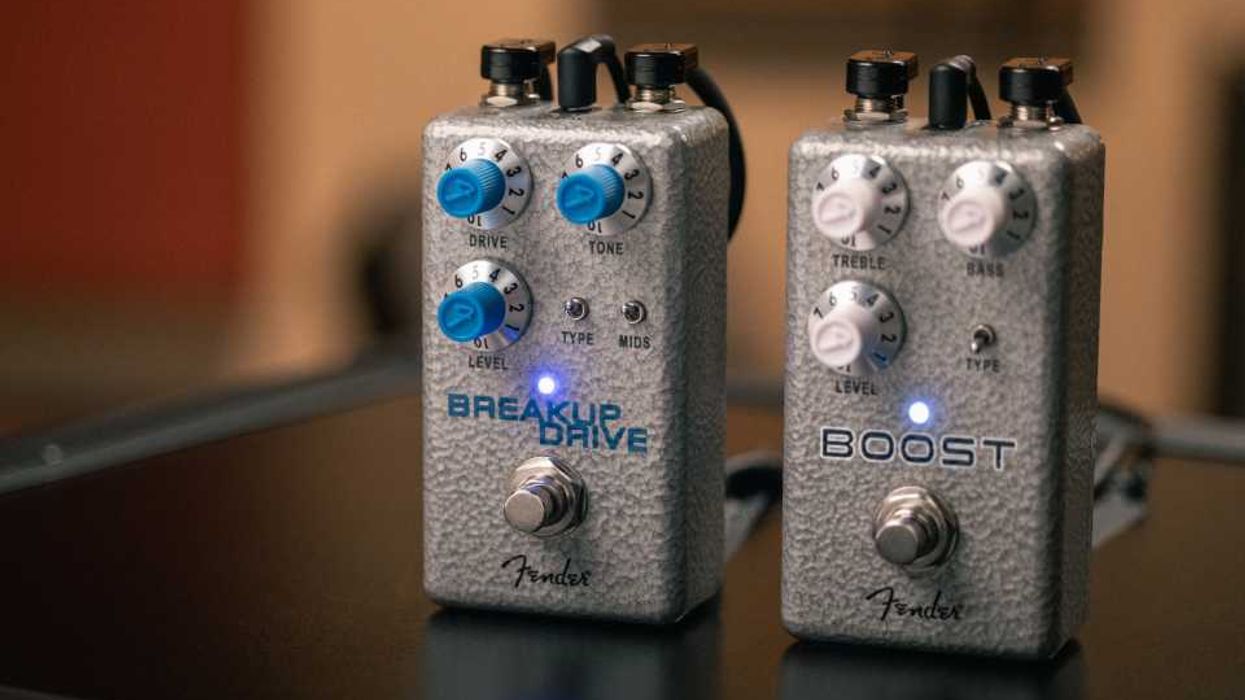
Today, Fender expands its Hammertone pedals series with two brand new pedals – the Hammertone™ Breakup Drive and Hammertone™ Boost. Built to be the essential building blocks of any board, the expansion of the Hammertone™ range offers players even more options to choose from – either used individually or stacked to suit any style and personality.
The brand new Hammertone™Breakup Drive provides responsive, tube-like overdrive tones with two clipping modes, giving players expansive control over their sound, while the Hammertone™Boost offers players the choice of cleanly boosting their solos or adding a warm, harmonic richness to their tone.
Hammertone™ Breakup Drive
($99.99 USD, £75.99 GBP, €89.99 EUR, $159.00 AUD)
The Hammertone™ Breakup Drive delivers responsive, tube-like overdrive tones in a compact, format. Built around a JFET-based circuit, it’s designed to replicate the dynamic feel of hot tubes pushed to the edge of saturation. Two selectable clipping modes let players dial in anything from light breakup to low-gain overdrive, each offering expressive responsiveness that cleans up with lighter picking and intensifies with more aggressive playing. An expansive tone control and a switchable pre-gain mid boost provide flexible frequency shaping to craft the perfect sound. Whether adding character to a clean tone or delivering touch-sensitive overdrive, the Hammertone Breakup Drive offers versatile performance for players who crave feel and nuance.
Hammertone™ Boost
($99.99 USD, £75.99 GBP, €89.99 EU, $159.00 AUD)
The Hammertone™ Boost elevates any rig with two distinct boost circuits housed in a single enclosure. Its Type switch allows players to choose between a clean, op amp-based boost for transparent volume enhancement and a JFET-based boost that adds warmth and harmonic richness, reminiscent of vintage tape unit preamps. With center-detented Treble and Bass controls, the EQ section offers easy access to a completely flat boost or precise tonal shaping—cutting or enhancing frequencies as needed. Whether used to cleanly boost solos, push an amp into breakup, or add subtle sweetness to a core tone, the Hammertone Boost delivers exceptional flexibility and performance.
Fortin Kali Review
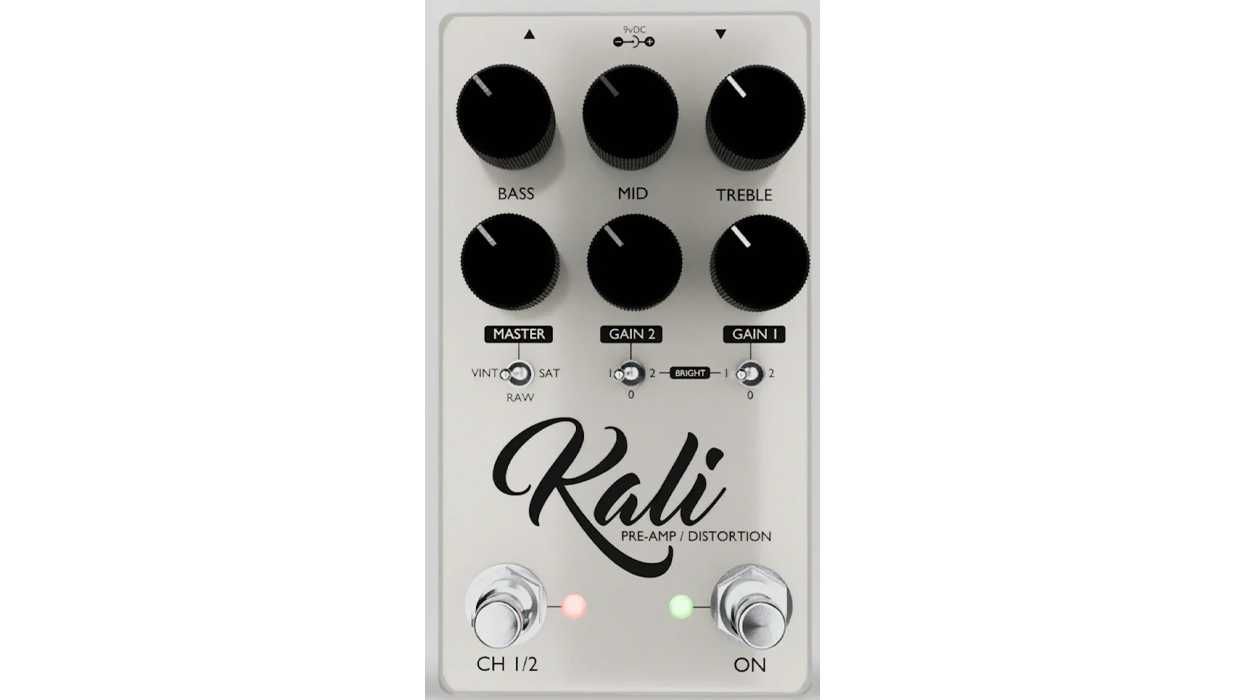
The aptly named Kali distills elements of the Fortin Cali—a Plexi-inspired amp—into a 2-channel pre-amp and distortion pedal. Each channel has three gain modes—vintage, raw, and saturation—which are selectable via a mini toggle. And each mode has a very distinct vibe, which could be loosely categorized as low-end-heavy, midrangey, and high-gain-centric, respectively.
Charging right into Kali’s arms, I selected the vintage mode on Channel 1, and set the gain 2 knob to 9 o’clock. The gain 2 knob, which controls the gain level that hits the circuit’s front end, is the default gain knob for both channels. The gain 1 knob, which adds additional gain stages, only works on channel 2. But even at this modest setting, I was already into toothy distortion that was very touch-sensitive.
Wide Range of Rage
Without changing any other settings, things got significantly filthier by merely switching over to the saturation mode. And even at this lower-gain setting, the output is tailor-made for heavy rhythm in a classic metal jam. Pumping the gain 2 knob to around 3 o’clock, meanwhile, makes the Kali a very in-your-face proposition, with sounds rooted in Sunset Strip/Jose Arredondo Marshall-mod energy.
Interestingly, even though saturation mode has the most aggressive gain structure, it doesn’t feel especially compressed. It’s also the quietest of the three modes when tested across identical settings. This was especially noticeable when I switched between vintage and saturated modes at high gain 2 settings. It follows, then, that raw mode—the pure sound of the pedal without any extra gain stages and essentially the preamp only—is the loudest of the three modes.
Well Put Together, With a Bright Personality
Channel switching is handled by one of the two footswitches (the other
is for bypass) and it enables you to cascade one channel into another. In cascaded-stage mode, gain knob 1 is active and serves as a pre-gain (hence the gain 1 designation). In saturation mode, with both gain knobs at noon, switching between the channels sounds organic. Channel 2 is generally thicker and sustains bends for a tad longer. But the two channels definitely do not feel haphazardly thrown together. They are clearly cut from the same cloth.
“[It’s] a very in-your-face proposition, with sounds rooted in Sunset Strip/Jose Arredondo Marshall-mod energy."
In general, the Kali is bright, but if you need brighter, there are a pair of 3-position bright switches for each of the two channels. At low output volumes the changes offered by these bright switches are noticeable but not too dramatic. They are much more pronounced at high output volume. The active +/- EQ knobs actually have much greater impact on the Kali’s personality—particularly in the zones between 9 and 3 o’clock, where minor tweaks yield very different tonal realms.
The Verdict
The Kali comes across as a cohesive whole, yet its interactive controls and powerful EQ unlock a wide range of Plexi and modded-Plexi tones. No matter how you set it, it sounds impressive.



